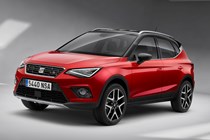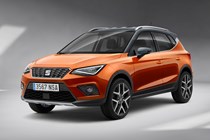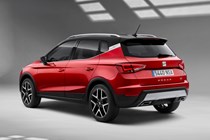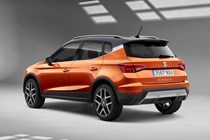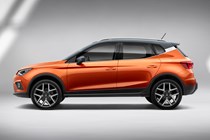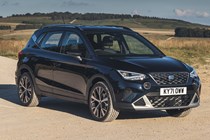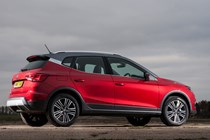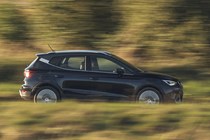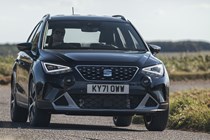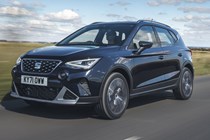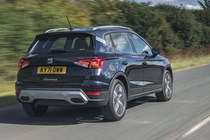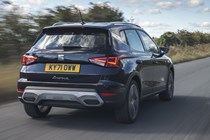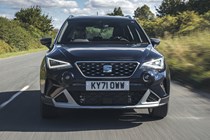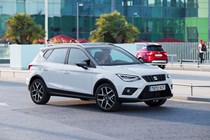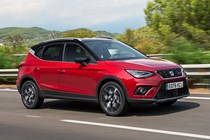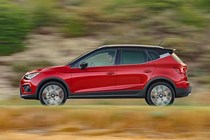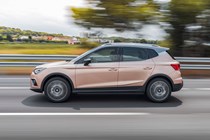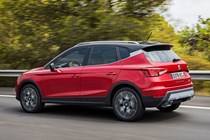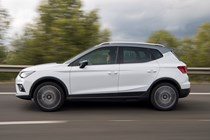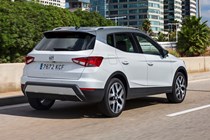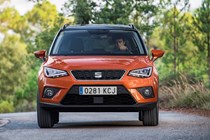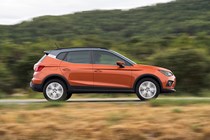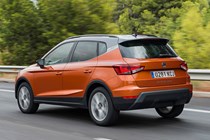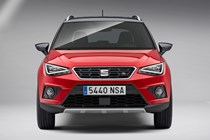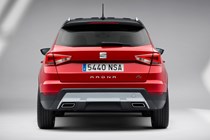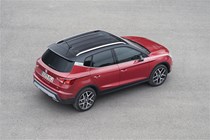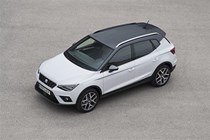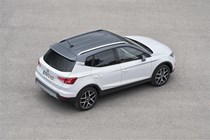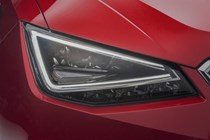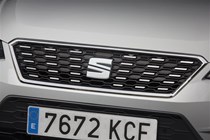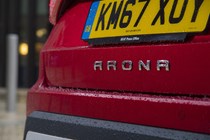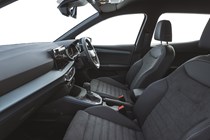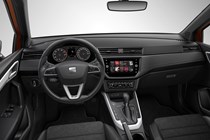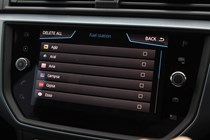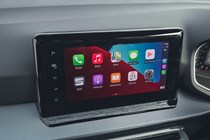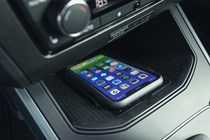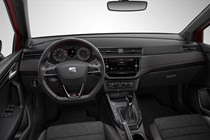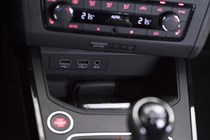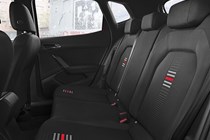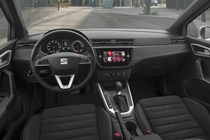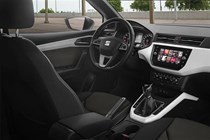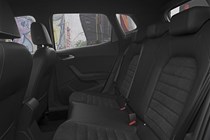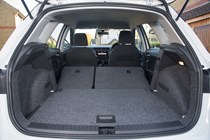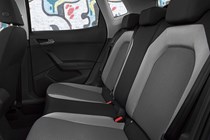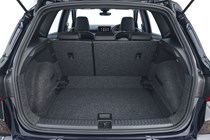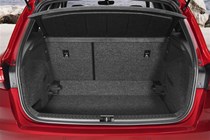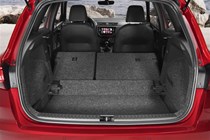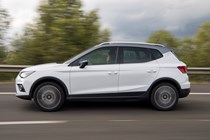
SEAT Arona long-term test
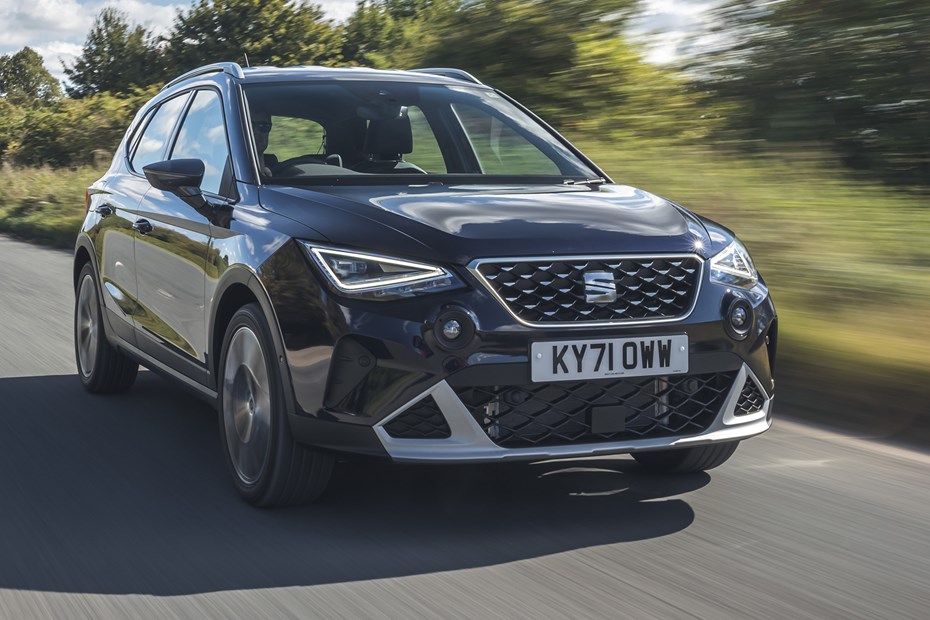
Living with a SEAT Arona
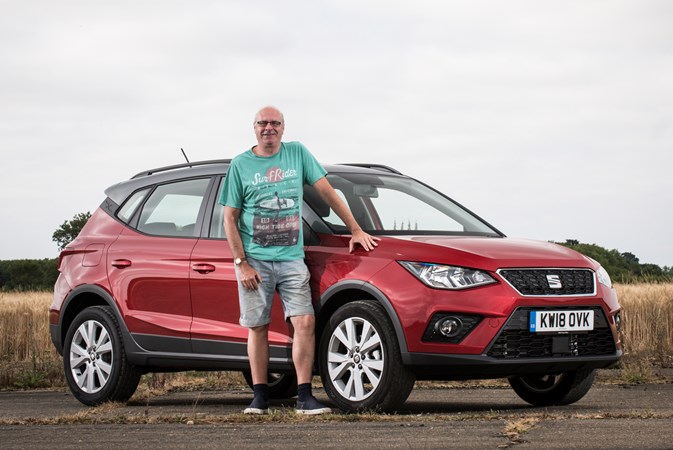
This week’s update: Time for some ‘Aronatherapy’. If you fancy being an owner, here’s our round up of what impressed us the most and hit the mark and likewise what didn’t quite cut the mustard.
| Scroll down or use the links below to navigate |
Update 1: Welcome to the fleet – ‘MyshArona’
Enter the ‘Lady in Red ’: a brand spanking new SEAT Arona SE Technology Lux 1.6 TDi 6 speed manual in a sexy and distinctly moody metallic Desire Red with a Monsoon Grey metallic roof.
The colour mix between the two variants is spectacular and, in the bright late spring sunshine, the car looks a dream. SEAT’s distinct sharp angular styling lines enhance the car even more. With only 68 miles on the clock, it’s pristine – straight from the manufacturer.
KW18OVK is my new long-termer for the next seven months. We’ll be in a getting-to-know-you phase over the next few weeks as I get close up to evaluate the brand new 2018 Arona.

Background
The Arona is SEAT’s latest SUV offering. Historically SEAT has not been in the SUV game very long. The first SUV (the Ateca), is a very accomplished affair and has already won multiple awards so we’re hoping for more of the same with the smaller Arona.
As with many of SEAT’s models, it’s named after a Spanish location, in this instance Arona is a small village close to Los Cristianos on the island of Tenerife.
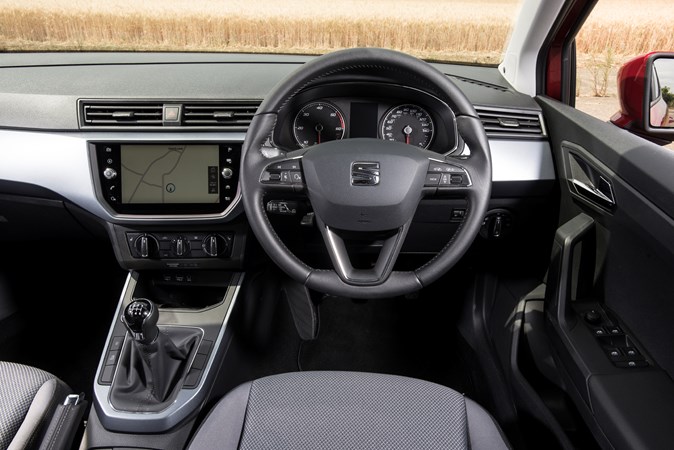
Trim level and equipment
Our new Arona is the SE Technology Lux trim level which has several enhancements over the SE Technology model. Additional equipment over and above those fitted to the SE Tech model includes keyless entry and go (aka KESSY), adaptive cruise control, heated front seats, heated front washer nozzles (aka the Winter Pack), and a BeatsAudio system consisting of 6 speakers, a high-end sub-woofer and a hefty 300w amplifier.
Standard fit equipment to this trim also includes 17 inch Dynamic alloy wheels with 205/55 R17 tyres.
Both trim levels are fitted with touchscreen satellite navigation, wireless phone charger and ‘Full Link’ smartphone integration as standard.
We’ll take a more enhanced look into all these features in the coming months.
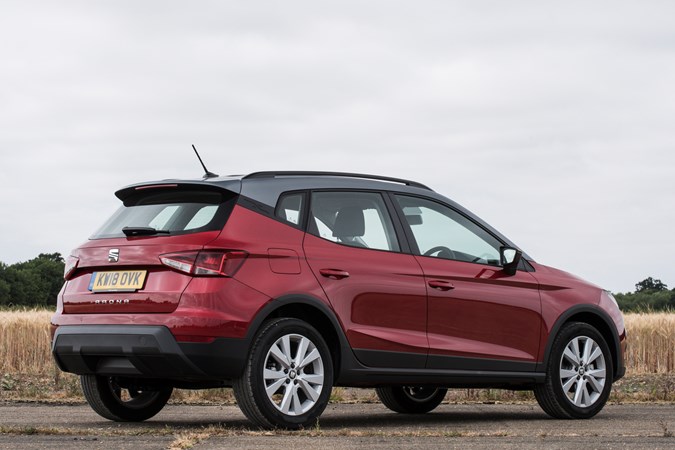
Inside
The interior trim of the SE Technology Lux is cloth, which comes as standard fit equipment for this derivative. Buyers can also select their own exterior and interior trim colours direct from SEAT’s website. The app is quick and easy to use and extremely user friendly. You can in a few minutes build you own car. See more here.
Boot and luggage space on the new Arona is 400 litres and our first visit out to the shops revealed plenty of space for a multitude of shopping bags and other goodies. We’ll delve more into its carrying capability later on when we stretch the Arona’s legs to see what she’s really capable of.

Running-in
There’s quite a lot of confusing information generally around about running-in. Advances in technology means components have much better tolerance than they did, say 40 or 50 years ago. I remember when my dad was running in his brand new Ford Cortina in the mid 70’s and the running-in regime was pretty strict.
The Arona owner’s manual gives information that the engine should be run-in over the first 1500km (900 miles) and not be stressed to more than 66% of maximum engine speed. After the 900 mile point, this can be gradually increased.
How the vehicle is driven in this early cycle influences the way it performs in the future. With a red-line of 5,000rpm, we’ll keep the Arona below the 2,500rpm mark – erring on the side of caution (and of course it’s not our car!). New tryes and brake pads also have a running in period although this is shorter at 300 and 125 miles respectively.
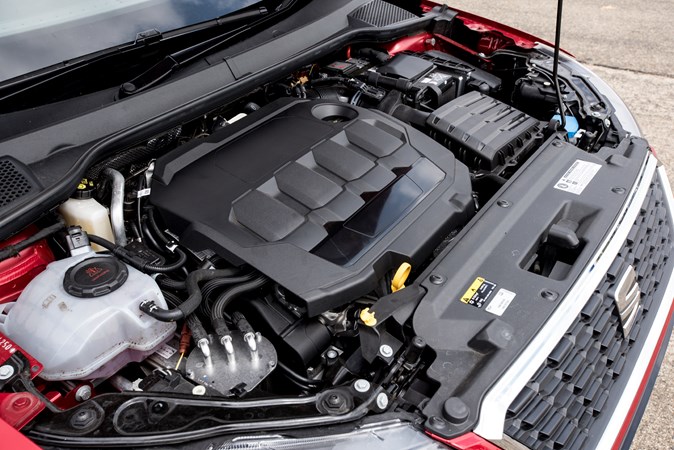
Manufacturer pricing and warranties
The basic price of our new Arona is *£16,829. Add the VAT (20%) and the total retail price (P11D value) reaches *£20,195. The first year RFL license for 2018/19 is *£205 and the first year registration fee (as it’s a new car) is *£55. The SEAT recommended ‘on the road’ price is *£20,455.
When you buy your new SEAT from a franchised dealership, your new car is covered by a standard three year/60,000 mile warranty which can be optionally extended to four years/75,000 miles for an additional £185, or to five years/90,000 miles for an additional £324.
The basic and the extended warranties are fully transferable should you decide to sell the car.
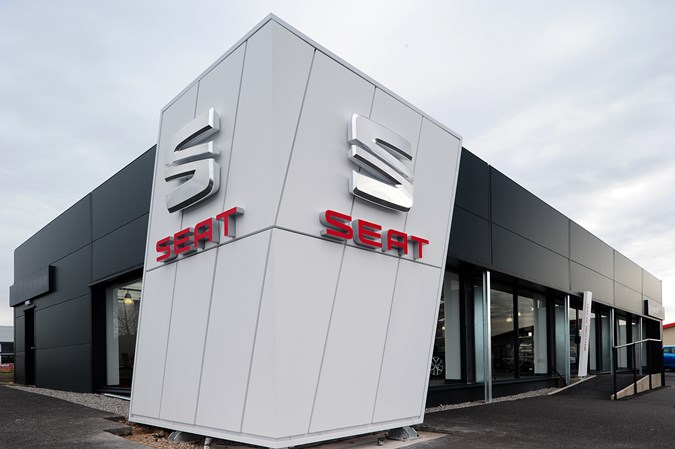
Manufacturer main dealer servicing
SEAT offer Arona owners a fixed price two year/20,000 mile servicing and maintenance plan.
Owners have the choice of a single up-front payment of £414 or to pay by monthly instalments of £22.99. In the included service booklet, I notice the first service isn’t due until 20,000 as SEAT employ longer intervals between servicing due to their Longivity service plan.
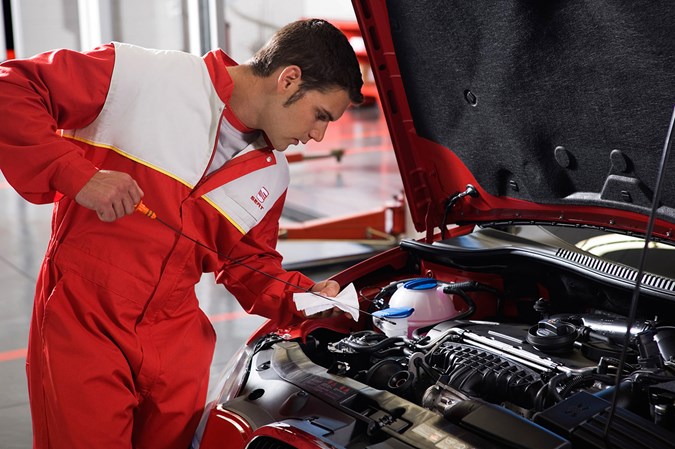
Specifications – at a glance
Engine: 1.6 Diesel 115hp, Euro6
CO2: 106g/km
0-60mph: 10.2 seconds
Max speed: 115mph
Combined manufacturer’s mpg: 68.9
Insurance group: 12E
BIK 2018/19: 26%
Full specifications SEAT Arona 1.6 TDi SE Technology Lux on Parkers.co.uk
Follow our thoughts over the summer and into the autumn of 2018 on how the baby SUV shapes up.
*Pricing correct at time of press. Data source – SEAT UK. Arona pricelist July 2018 V2
Update 2: First driving impressions
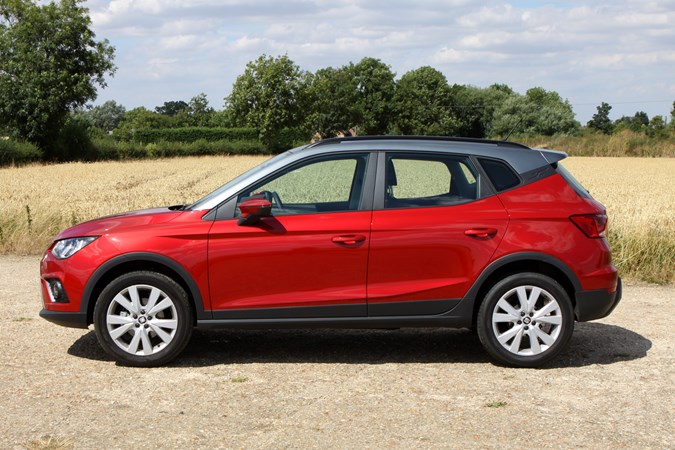
The Arona has now been with us for a few weeks and I’ve had a good chance to get some initial driving impressions. The car feels more like a maxi version of an Ibiza, or to put it another way, a mini version of the Leon.
Sitting in between the two it sort of struggles to find its own identity especially when looking at the pint-sized SUV format. Width-wise, it’s the same as the Ibiza at 1.78m but with an increased height at 1.55m and a slightly larger boot. However, when you give the car a good look over, especially when viewing sideways on, you can’t dismiss actually how damn good it looks.
I’ve tried to get my head around the tiny SUV idea for a while and struggle with it, but actually I think it’s more about the styling rather than the functionality that wins the day.
Even friends around the office and my local village say what a good looking car it is with the sharp angles enhancing some smooth lines.
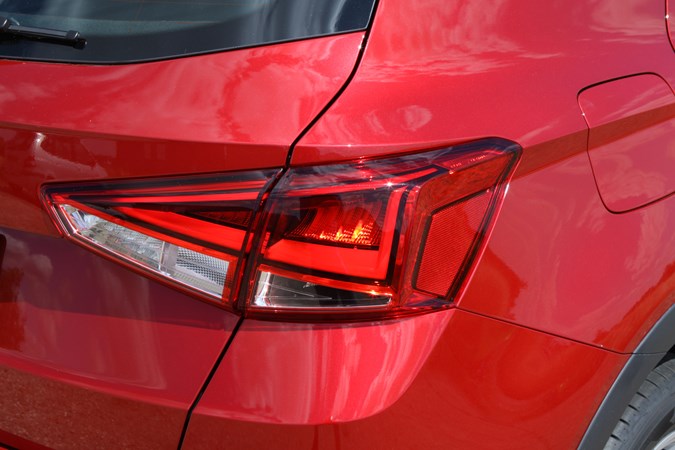
On the inside the Arona is large enough for four adults. You could fit five in, but it would be quite cosy even with the increased SUV height. Four plus one child in the smaller center seat is about the limit.
The seats are comfortable, if not plush, being more functional than luxurious. I was surprised that a journey of 2-3 hours didn’t produce any rear-end ache often associated with some interiors. On the contrary – the seating did a good all-round job, but we’ll see in later updates how she fares on a lengthier journey.
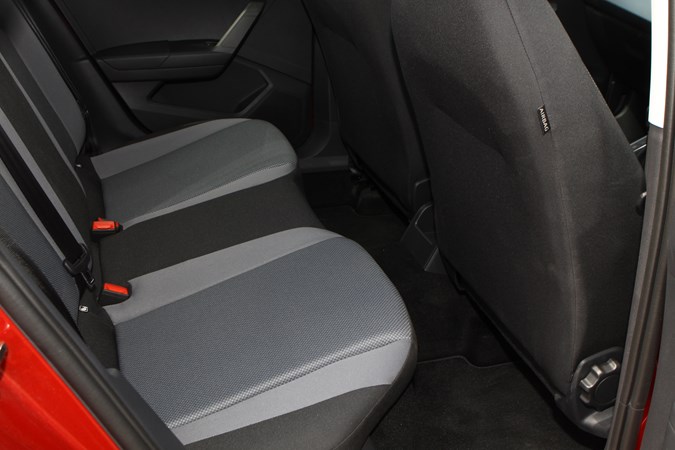
Stealth fighter
We love the exterior styling. There’s something about the nice sharp stealthy angles, especially on the wing mirrors and front/rear lights that make it look more like an F117 Nighthawk or B2 Spirit spin-off. Not that you need a reduction in radar signature on your new Arona, but it wouldn’t look out of place outside the Skunk Works!


Were the Arona’s design team influenced by military aircraft design and technology?
For protection, all of the lower external sills and around the front and rear wheel arches are covered with a small but tough exterior plastic trim. This fully extends unbroken around the front of the car and onto the rear bumper. SEAT have obviously looked carefully at this and seemed to have come up with a good all-round protection solution.
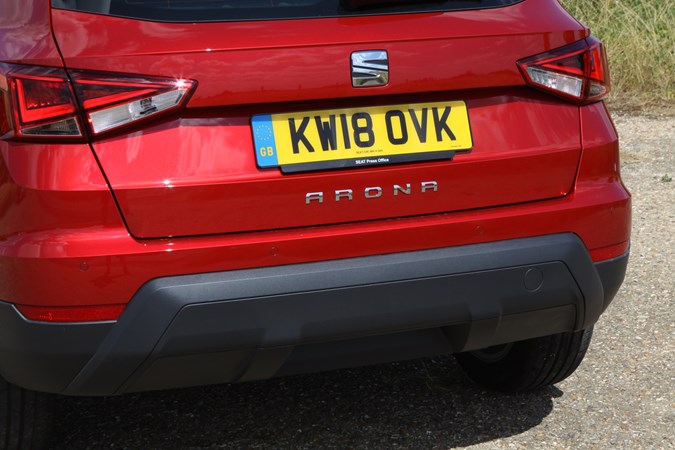
Driving
Our first impression is how nimble the car is. It responds quickly with very little driver input and handles more like a small city car. It excels when manoeuvring in or out of small tight spaces and feels very much at home in a town or city environment. The 1.6 TDi 115hp engine also works extremely well.
The ride on the standard 17-inch alloy wheels is good and the car exhibits a decent balance between comfort and body control. Popping the car quickly into a corner doesn’t upset it as it huddles the road well on the stock Hankook 205/55 R17 Ventus Primes without too much roll or dip, even on our potholed UK roads.
Both driver’s seat and steering wheel also have plenty of adjustment options so it’s easy to find a comfort vs driving ‘happy spot’.
On the brakes, the Arona is sharp and not at all sloppy with two driver aids. I found the action of the ESC and ABS combination really good as I needed to apply some swift braking in both wet and dry weather conditions on a couple of occasions.
The ESC is an interesting addition to the standard ABS affair that we’ve all been used to over the years, in that the system uses the steering wheel angle and road speed to calculate the changes of direction desired by the driver and constantly compares them with the actual behaviour of the vehicle. When things get out-of-shape, for example the vehicle begins to skid, the ESC system brakes the appropriate wheel automatically.
On both occasions the system controlled the car very well preventing any skidding or drifting off-line, braking sharply and bringing the car to a quick halt without any fuss.

Boot space
Initially the boot doesn’t look that large until you find the secret panel in the boot floor used to hide contraband and booze. Kidding aside, the movable floor panel is a great idea enabling a extra few centimetres of boot depth which can be really handy. If you put that into context, the Arona actually offers more space than a VW Golf.
We’ll see how this shapes up in practice as we plan to load it full of Pasties for a long weekend in Cornwall.
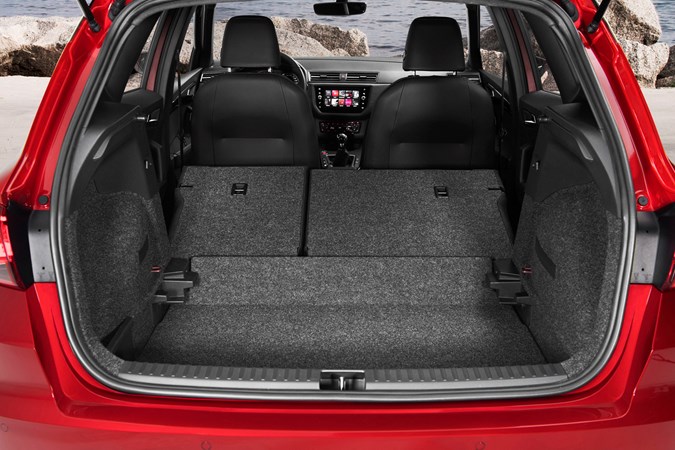
Engines
The Arona currently sports five engine choices, three petrol and two diesels – so the choice of power plant is good.
The smaller capacity petrol variant starts with the 1.0 TSi three-cylinder unit which produces 95hp and returns 57mpg. Moving up the chain we again have the same 1.0 TSi unit but this has been re-worked to a more usable 115ps.
At the top of the tree is a 1.5 TSI four-cylinder unit, producing a hefty 150hp and returning an excellent 56mpg in the process. Although this engine is not fitted to our test car, we’ll have more on this unit later on as we look closer at engine choices across the range. The 1.5 150ps TSI option is currently only available with cars in FR and FR Sport trim levels.
Slotting alongside the petrol are the two diesel variants with the 1.6-litre four-cylinder offering 95 and 115hp. The diesels offer enhanced fuel economy of 64 and 65mpg respectively, while the 115ps engine offers a good sprint to 60mph of only 10 seconds, making it pretty nimble off the starting blocks.
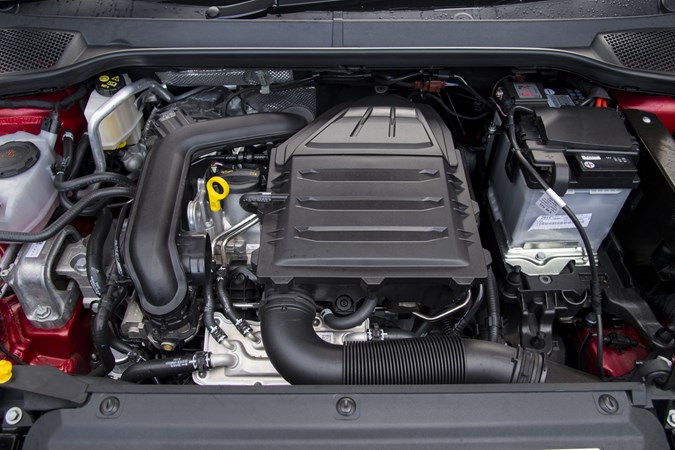
The shopping trip
All of the Parkers long term fleet are subjected to the proverbial shopping trip. It’s one function that none of us can get out of, so, as like previous write ups, the Arona was loaded with an array of shopping bags after a £200 spend in Aldi.
Knowing that our good friends in this particular supermarket chain offer extremely good value (quick plug:), we find that this will often fill a good sized boot. Our trip proved no different and we managed to fit 12 shopping bags without piling any of them on top of each other, so in typical Eurovison manner we award the Arona the maximum ‘Douze Points’ for the shopping experience – one for each bag!.
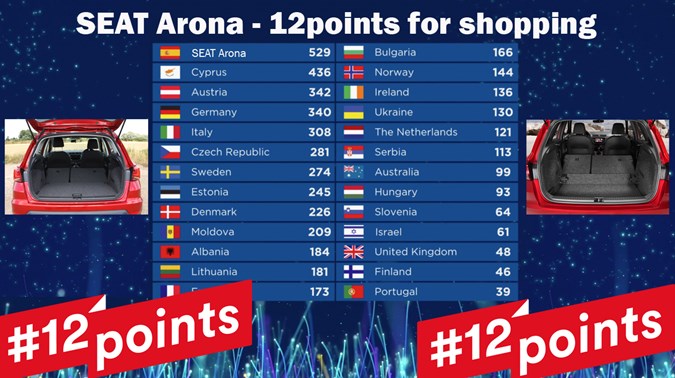
Our Arona likes a drink!
Even after the first few weeks we’ve been conscious that we’re not getting anywhere near the claimed 68.9 mpg combined cycle. Even taking the fully loaded ‘four-up’ trip to Cornwall out of the equation, we’re still only managing around the 49mpg mark. We’re concious that the car is new and that new engines are known for being slightly tight. Some require a few thousand miles or so to loosen up.
Our tester also has some pretty good history in the art of being frugal, taking the Suzuki Ignis from Land’s End to John O’Groats on £60 worth of fuel. So over the coming weeks we’ll look into this more closely and see where and how we can improve the figures and whether a few more miles under our belts will help push the figures higher.

Update 3: Off to Cornwall on the ‘Pasty run’

Ok I hear you! – It’s the update you’ve all been waiting for. The mouth-watering drooling run to the land of pasties, tin mines and Jethro. OK, Poldark as well – I’d never hear the last of it if Captain Ross didn’t get a mention.
After taking the Skoda Superb Estate for a long weekend in Cornwall back in the summer of 2017, it seemed a pretty good idea to repeat the experience – this time with SEAT’s new Arona to see how well it coped with a full load, four occupants (three quite hefty may I add), and all those microscopic Cornish roads. Plus the fact that the guys in the office had got a real taste for ‘proper pasties’, it was a no-brainer so I was duly sent packing.
Penzance or Perth?
So with a similar itinerary in 2017 and a large pasty order, I loaded the Arona with two medium size cases and what looked like enough luggage for a six month stay in Australia.
What became apparent quite quickly was that we’d need to do some creative packing of cases and bags as the Arona didn’t quite have the storage capacity the Superb had.
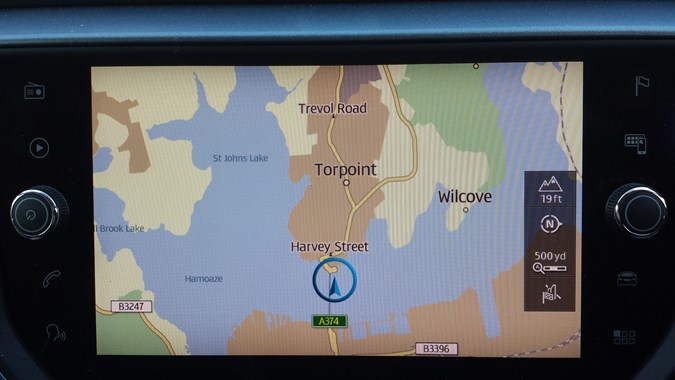
Trying to fit the cases in flat didn’t work: even with the height-adjustable floor lowered, the top case proved to be too wide, preventing the boot lid from shutting. Also we’d piled some smaller items under the boot floor so the extra boot height was immediately wiped out. With this in mind I removed the parcel shelf and stacked the cases on their sides which still didn’t work. The same problem occurred – the boot lid wouldn’t close.
Eventually the cases were placed vertically side by side and pushed to the rear of the boot and, with a little amount of persuasion and encouragement, just fitted in below the roof space. However the parcel shelf had to be left behind. Additionally, a few small bags and other items were scattered around the larger cases to fill in the gaps but after a few minutes we’d hit our limits and struggled to get anymore in. It was well and truly stuffed to the brim.
Now onto to the cars’ occupants. Four adults with two of us on the rather large size (to keep the peace I won’t reveal who fell into which group :). This added about 330kg to the load and I had visions of the small Arona coughing and wheezing all the way down to the South West. Cars boiling up on the A30 over Bodmin Moor are a thing of the past thankfully.
However my doubts were mere fantasy as we set out at 2.30am to avoid traffic fully loaded and raring to go. The car handled the additional loads and weight extremely well, actually making quite light work of the trip. Only on the odd occasion did you need to drop down the gearbox in order to get the expected response.

What I did note is that the 1.6 TDI 115hp power unit seems happiest at around 1800 revs or above – and up to around 3000 revs. Here the power band is at its most potent and usability the best. Dropping below 1800 revs made the car rather unresponsive and putting your foot to the floor didn’t create much in the way of action. We’ll look more into how responsive and torquey the engine is later in the review and also without additional luggage and people to get a better balanced view.
Routing from the Northants/Cambs border we opted for a slightly changed route compared to 2017. As the M6 was closed at Coventry, I decided on the A605/A45 Northampton, A43/M40/A420 Oxford Swindon then M4/M5 Exeter and finally the A38 Devon expressway to Plymouth Devonport.
Traffic was light as expected and the only drivers around were other night-owls doing the same thing as we were and the relentless array of trucks toing and froing goods to the South West.
As we’re the nostalgic bunch we always take the ferry at Devonport to cross the Taymar rather than going over the Taymar bridge. One point to note is if you are travelling from Devon to Cornwall using the Taymar Bridge (A38) it’s free. A small token charge of £1.50 applies to cars without trailers when coming from Cornwall into Devon. The same applies if using the ferry – it’s free when going from Devon to Cornwall but a charge of £1.50 for cars applies coming from Cornwall (Torpoint) to Devonport.
The ‘Arona who loved me’
What was very interesting was how the sat-nav handled the ferry crossing. The road down to the ferry terminal is the A374 although by the time it reaches Devonport it’s more like a side street. The same road continues on the opposite side of the river at Torpoint and is still labelled the A374. It was highly amusing to see the navigation system build its own road structure across the river. My friends were in hysterics as the jokes rolled off one after the other comparing the Arona to James Bond’s Lotus Esprit S1 (‘Wet Nellie’) that handled underwater drives extremely well.
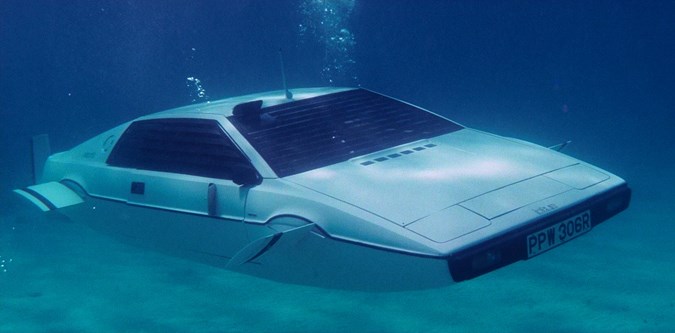
After all the chuckling and belly laughing was over, we re-joined the A374 at Torpoint entering Cornwall. Looe was only another 40 minutes’ drive and we arrived just before 9.00am ready for a ‘Full English’ as the overnight run seems to always give everyone a good appetite.
During the course of the weekend, the Arona was subjected to the usual array of twisting and winding Cornish backroads, some being extremely narrow. The road to Mousehole springs to mind as do many other minor roads which go down to some of the smaller villages and harbours.

Saying that, the smaller Arona was very nimble and coped well with the quick stop/slow-down/start routine that was all too familiar given the quite heavy volume of holiday traffic during the days. The steering is not overly light and gave good driver feedback and at times the SUV actually felt more like a city car nipping in and out of a variety of situations with ease and having good engine response when needed.

As promised, the car was duly laden with a box full of pasties as a trip to Cornwall wouldn’t be complete without them. Stars of the show this year were offerings from ‘Sarah’s’ and the ‘Cornish Bakehouse’ (Winner – 2017 World Cornish Pasty Champion) – both based in Looe.
Padstein
As our trip seemed to be solidly based around food (this seems to be the case wherever we travel), we decided to make a detour to Padstow. The small town on the North Cornish coast is often referred to as ‘Padstein’ – a nickname based around TV celebrity chef Rick Stein who reportedly owns half the town.
The chef seems to have played a good marketing card as the town was choc-a-bloc with tourists and day-trippers, most clamouring around the take-away fish and chip outlet. We decided to join in the brawl and check out ‘Stein’s Fish and Chips’ which was good but opinions were split with two of us saying ‘Mary Jane’s in Cromer’ was the better option. See our Suzuki Swift long term report here for more. On the flip side, the Salt and Pepper prawns rocked!
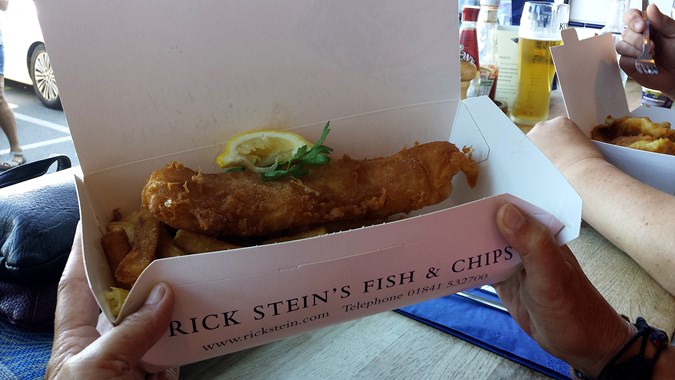
During each of our day trips we added slightly more weight to the Arona as the quantity of pasties and souvenirs increased – now even the rear seating area had little storage left. When comparing the Arona to the much larger Superb we had the previous year, the smaller Arona was welcome over the narrower Cornish roads. In 2017 the Skoda Superb was a real mile-muncher but we missed the extra storage of the larger car.
So it was time for home as our four-day break was approaching its finale. With food still on his mind, my accomplice Nick devised of a way of taking in some culinary delights (he was a chef in a past life!). We decided on the return to go via the A30 and made an early stop at Jamaica Inn.
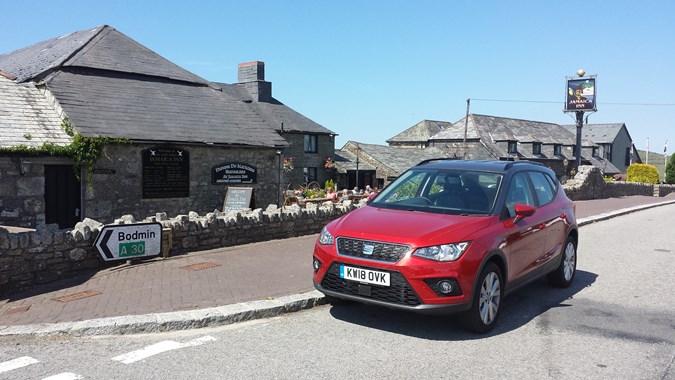
Jamaica Inn is located high up in the wilds of Bodmin Moor and made world-famous by Daphne du Maurier’s tale of smugglers, rogues and wreckers. This historic coaching house has welcomed weary travellers crossing Bodmin Moor for nearly 300 years. Full of legend, mystery, romance and even, according to folklore, the odd friendly spirit, we decided upon a late lunch and take in the ambience of the whole affair.
It’s not often Bodmin Moor basks in 28 degrees of warm sunshine so I took the opportunity to do some photographic work with the Arona.
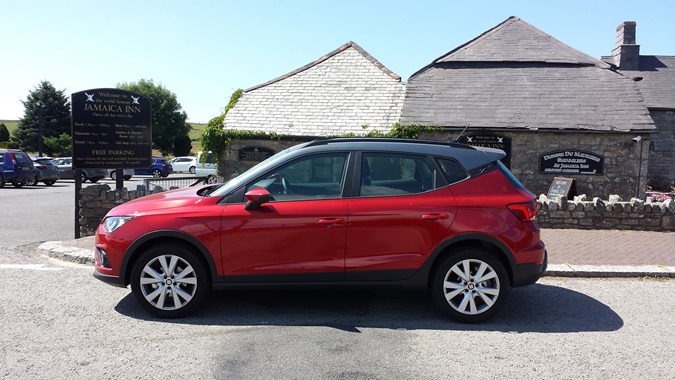
After eating lunch and watching England win their world cup quarter finals match we got under way again heading eastwards on the A30 over Bodmin Moor with the Arona making quite light work of the full load and all four occupants.
The 1.6TDI 115bhp diesel engine fitted to the car is quite peaky but requires a reasonable amount of revs to spur it into action. I found that keeping the engine singing at 2000rpm or above was the best option given our load and weight. Even so there was still ample in reserve as twice I needed to accelerate out of danger and on both occasions the car never failed to deliver. Checking the manufacturer data reveal the engine’s max torque is achieved at a quite high 3200 rpm rev limit – hence the engine needs to be worked a little (Plus Nick had put on another stone or so whilst we were away).
To check out our route see the map below or click here for the full route on Google maps
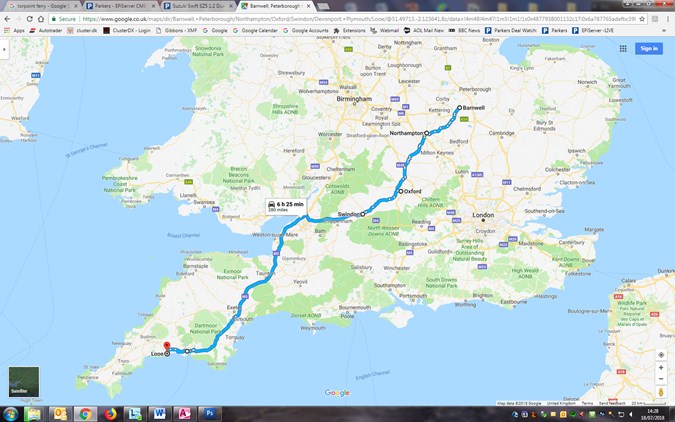
Update 4 – Engine choices – Arona 1.6TDI (115ps) or 1.0TSI (115ps)
Shortly after taking delivery of our Arona long-termer, another one almost identical to ours arrived at the Parkers office. The colour scheme was different in that the car was finished in Eclipse Orange with a Midnight Black roof, plus it was specced in ‘FR’ trim.
There are key differences between the two trim levels with the SE Technology Lux having various enhancements over and above the FR. The major and most distinct items being KESSY (Keyless entry and go), twin bulb halogen front headlights, an enhanced anti-theft alarm system, Beats audio, adaptive cruise control and a winter pack.
However the main reason in grabbing the FR (apart from it only being with us for a few days), is to evaluate the differences between the long-term car (fitted with the 1.6-litre TDi 115ps engine), and the FR – which is fitted with the 1.0-litre TSI 115hp engine. So two engines both have the same power output, but one is fuelled by petrol and one by diesel.
Read on to see what we thought of each car and the perceived differences between the power units and see which one has the knack.
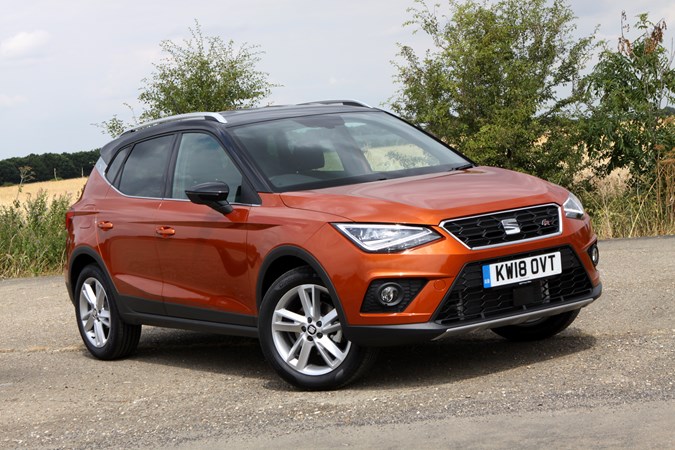
SEAT Arona 1.0TSI (115ps) FR
The short-term FR Arona has the three-cylinder 1.0-litre TSI engine fitted. TSI engines almost have their own characteristic signature note as when you accelerate a rumble is heard which develops into a whine as the unit grapples and accelerates through the rev range. As with most TSI engines it wants to be revved and the harder it’s worked the better it seems to perform.
Power is fairly smooth and linear all the way up from 2,000rpm and peaking at around 6,000rpm. The 1.0-litre unit fits in well with the Arona and makes it feel quite sporty. SEAT have however gone the extra mile offering a 150hp version using a 1.5-litre TSI power plant, which has a combined fuel consumption of only 2.2mpg less (55.4mpg compared to 57.6mpg respectively) than the 1.0-litre TSI – so there’s not a huge advantage in having the lower capacity engine.
SEAT Arona 1.6TDI (115ps) SE Technology Lux (My ShArona)
Our main long term car has now been with us for over two months and we’ve now had a good chance to get to know how the car performs across a variety of driving scenarios and conditions.
Our first thoughts on the TDI engine is that unlike some diesel units which have high torque figures quite low down the rev range, this particular unit has its maximum torque at a quite high 3,200rpm. In real terms this means the engine needs to be revved a little harder to get the required performance out of it. Saying that, the performance is certainly there and, if anything, the engine is slightly more reminiscent of a petrol engine rather than a diesel.
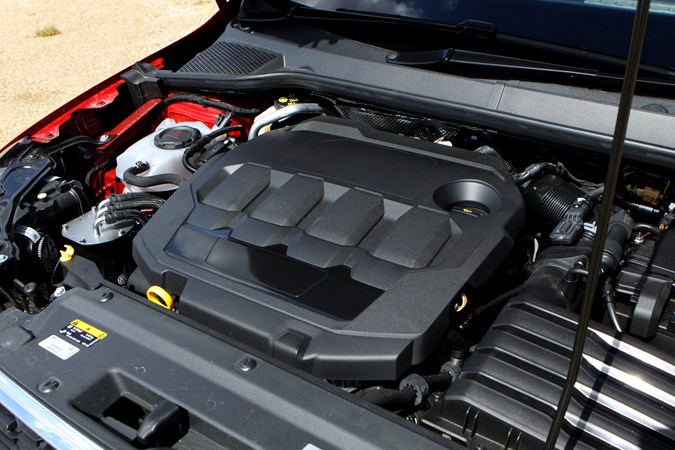
Driving
The SE Technology Lux has only one single driving mode compared to four (Sport, Normal, Eco and Individual) in the FR. Both variants drive almost identically when the FR is set to ‘Normal’ and we couldn’t notice any significant difference in the ride between either. It’s a slightly different story with the FR when you engage the ‘Sport’ mode which livens up the engine somewhat, making it more responsive and also stiffening up the ride; although the transformation is not as pronounced as we’d anticipated. The ‘Eco’ setting which can drain some cars of any personality feels quite subtle. It does not have the wild shut down and feeling of someone turning off 25% of your engine.
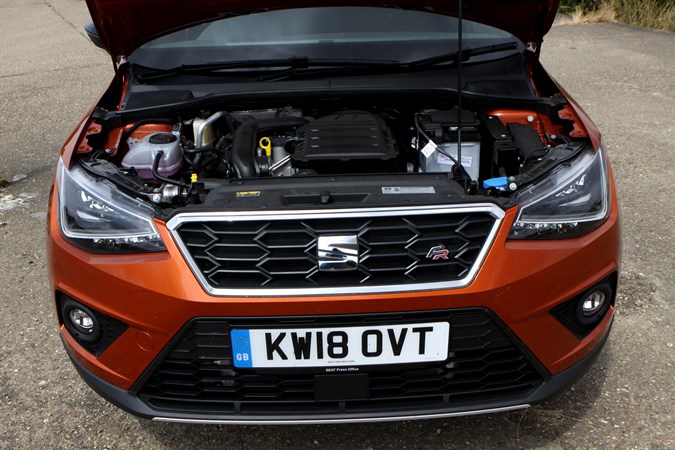
Handling (SE Technology Lux)
In the corners the car did not suffer from excessive body roll and sat firm and square even when pushed hard. When there’s no load and only the driver in the vehicle the ride can be slightly bouncy if driven eagerly, but the bounce reduces if the car carries any weight and even one passenger makes a difference.
Handling (FR)
The FR has four user selectable performance settings. In ‘Normal’ mode it seemed to be very similar to the standard SE Technology Lux setting. I couldn’t detect much difference between the two. Changing up to ‘Sport’ mode and the car’s characteristics changed, but only minimally, despite noticing the car becoming livelier with marginally stiffer suspension. This enabled the car to handle better at faster speeds especially through the corners with a reduced amount of body roll.
Trim wise the FR variant has a slightly different interior feel and is fitted with FR Sports seats. Both cars have cloth upholstery fitted and comfort was about equal between the two.

Would we choose the 1.6TDI in favour of the 1.0TSI?
For potential buyers the choice comes down to fuel economy and usage. High mileage users could consider the diesel variant as the fuel economy is around 8mpg better. However as always there’s no such thing as a free lunch and on the flip side the diesel engine in the same trim costs over £2,000 more. Also factor in that diesel fuel is generally about 3-5p per litre more expensive than petrol so it’s a real swings and roundabouts affair. You would have to cover a lot of miles to re-coupe the extra initial spend so we think we’d opt for the petrol variant but read on more.
Hang on – there’s a wild card in the mix!
Enter the sporty 1.5 TSi petrol variant. For those wanting the performance edge it’s an obvious choice. The 1.5 TSI (150hp) petrol engine offers fuel economy which is pretty much on-par with the 1.0 TSI (115hp) unit, but gives a far superior performance boost knocking 1.5 seconds off the 0-60 time in comparison to the 1.0 TSI petrol and 2.2 seconds quicker against the 1.6 TDI.
As an additional bonus, the initial cost of the higher performance variant is only £1400 more than the 1.0 TSI and is still £500 cheaper than the diesel – so the 1.5 TSI gets our vote. We’ll chat with our nice friends at SEAT to see if we can grab a few days in the 150hp version just to get a feel of its qualities.
We’ve listed below some various power plant options although not every engine is available for all derivatives so we’ve given you a selection as an example.
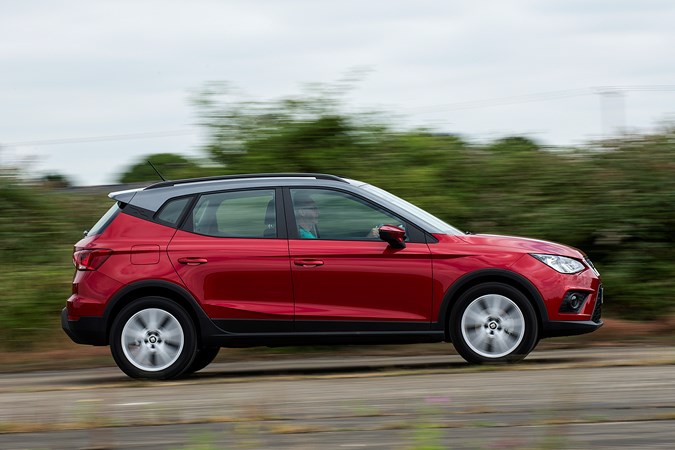
Engine specifications
See below at our ‘At a glance’ specifications. Click on the links to find out much more as there’s everything from boot space to insurance groups.
1.0TSI engine: (Example from our 1.0TSi FR derivative)
0-60mph: 9.5 seconds
Power: 115ps (113bhp)
Urban fuel usage: 47.9mpg
Extra Urban fuel usage: 65.7mpg
Combined cycle fuel usage: 57.6mpg
CO2 emissions: 113g/km
See the full specifications here
https://www.parkers.co.uk/seat/arona/suv-2018/fr-10-tsi-115ps-5d/specs/
1.6TDI engine: (Example from our 1.5 TDi SE Technology Lux derivative)
0-60mph: 10.2 seconds
Power: 115ps (113bhp)
Urban fuel usage: 57.6mpg
Extra Urban fuel usage: 70.6mpg
Combined cycle fuel usage: 65.7mpg
CO2 emissions: 114g/km
See the full specifications here
https://www.parkers.co.uk/seat/arona/suv-2018/se-technology-lux-16-tdi-115ps-5d/specs/
1.5TSI engine: (Example from a 1.5 TSi EVO FR Sport derivative)
0-60mph: 8.0 seconds
Power: 150ps (147bhp)
Urban fuel usage: 44.8mpg
Extra Urban fuel usage: 64.2mpg
Combined cycle fuel usage: 55.4mpg
CO2 emissions: 115g/km
See the full specifications here
https://www.parkers.co.uk/seat/arona/suv-2018/fr-sport-15-tsi-evo-150ps-5d/specs/
So from an initial tug-of-war between the two 115hp power plants, we think the wild card choice of the 150ps 1.5 TSi unit could make an excellent choice.
Check out a future update as we call upon the expertise of Parkers finance guru, Christofer Lloyd to see what an Arona will cost you in the real world and how it stacks up against the opposition.
We’ll have PCP and PCH finance examples together with various other purchase options such as cash deals, personal loans and HP so there’ll be a plethora of information for you to glean through.
Update 5 – Total Recall
Our five seat Arona now becomes a ‘four-seater’
A very important advisory letter from SEAT recently arrived at the office with reference to a possible safety issue: the seatbelt buckle for the left rear seat opening inadvertently.
Quoting from the manufacturer’s letter:
“SEAT has discovered that there is the possibility of Arona and Ibiza vehicles of the belt buckle for the left rear seat position opening inadvertently in a specific driving situation.Your vehicle is affected by this.
This hazardous situation can occur when the left (in the direction of travel) and middle seat positions on the rear bench seat are both occupied at the same time.
If the error occurs, the passenger will no longer be secured by the installed restraint system in the event of an accident or emergency braking which could potentially cause a high risk injury.
For safety reasons we would therefore ask that you do not use the rear middle seat position until the twin seat buckle had definitely been repaired.”
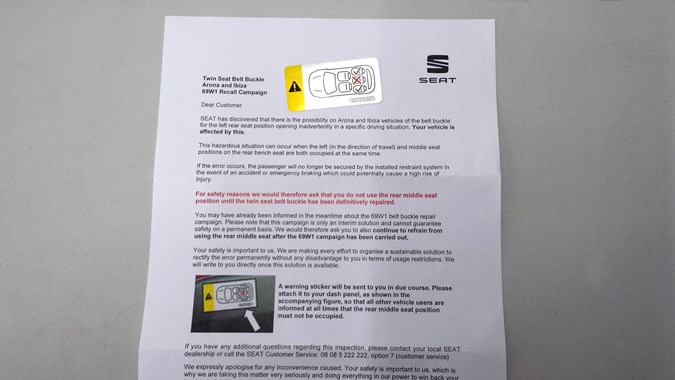
The letter goes on to advise owners that a recall campaign (Recall 69W1) is currently underway. Additionally the letter advises owners to place a sticker on the dash panel to warn other vehicle users that the middle position seat must not be occupied.

We have yet to have been advised on the required fix or how long it may take, but we’re presuming that our Arona will at some point be visiting our local SEAT dealership to remedy the problem.
SEAT go on to say that owners will be contacted in due course.
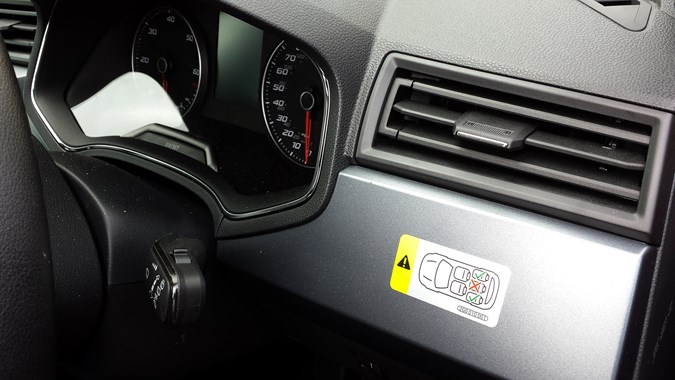
So what’s the exact problem?
It seems that a fault has been identified in that when a car is driven at speed with the three rear seatbelts in use, the far-left buckle could potentially become undone. This is caused by the centre seat belt buckle pushing down on the left-hand buckle causing it to unintentionally release, and as a result, a passenger in the left hand seat becoming unrestrained.
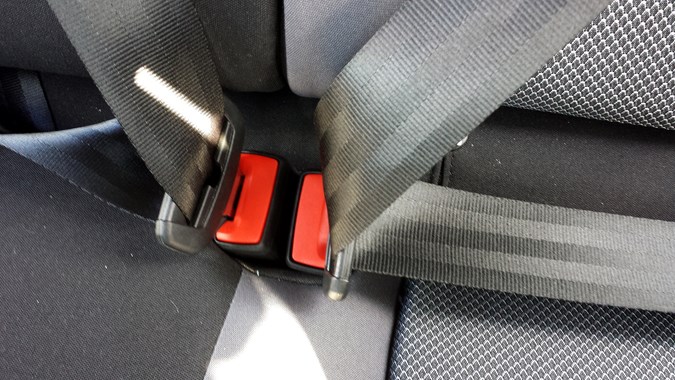
A Temporary fix has been suggested
The patch involves securing the central and back-left seatbelts together and changing the height relative to each other. This in theory should minimise the chances of the buckle being inadvertently released. However, on our own car, trying to pull one buckle out more (thus making it higher) proved quite difficult. As you can see from the images, the height hasn’t changed that much. I think we’ll let the dealership look at it.

As this recall is obviously safety related, we’ll be looking to get our own Arona into the workshop as soon as possible. We understand that a permanent factory fix will be available from November 2018 onwards. We’ll report back on how things go and what went into the fix.
Update 6: Scalpel in hand – we’re ready for a ‘Beats audio’ disection
Move over ‘Smashy and ‘Nicey’ – 70’s DJ, disco aficionado and afro wearing Parkers production man, ditches his 12 inchers to try out some alternative musical medicine courtesy of rapper ‘Dr. Dre’.
When it comes to audio then my interest perks up somewhat.In the 70s (when I once had hair) I worked as a DJ in various nightclubs and also hosted a regular jazz/funk and soul slot on hospital radio for over six years up to 1984.
Pirate radio
It was in the days when pirate radio was in its heyday and the likes of ‘Radio Caroline’ and ‘Laser 558’ are still firmly etched in my aging brain. Over the years I’ve collected some fairly high-end audio processing kit and presently run a Neumann TLM103 mic and an Avalon VT-737SP Class-A tube channel strip processor with my ham radio kit, so I’m always keen to get my hands dirty with a new sound system whether it be AF or RF.

So enough of the reminiscing and flairs – let’s get down to business. Our Arona is in SE Technology Lux trim and is one of only two trim levels (the other being the XCELLENCE Lux) which are fitted with a Beats Audio system, however this is not to be confused with the trim level Arona that is called the Beats Special Edition which is not the same car and not available in the UK. This is a European car with a different feel and set-up.
Unfortunately, the factory info on the Beats audio in the Arona is pretty sparse. I found myself hunting the interweb for quite a while before actually asking our nice friends at SEAT if they could give me any more info. Even then there’s not too much technical information to glean over.
The Beats brand was founded by music producer and rapper Dr. Dre and Interscope A&M records co-founder Jimmy Lovine back in 2006 and is synonymous with the rise in popularity mainly of electronically EQ’d ultra-expensive aftermarket headphones. An area frequently sneered and jibed at by true audiophiles.
Today with various changes in the structure and a really rocky path over the years (including the odd law suit or three), Beats is actually now owned by technology giant Apple.

The heart of the system is a DSP (Digital Signal Processor) and a 300w amplifier which is located underneath the passenger seat. The unit drives seven sound system speakers in total. Two full-range door speakers, two full-range speakers in the rear, two tweeters in the A-pillar for the high frequencies and one subwoofer integrated in the spare wheel well.
On closer examination the sub seems to comprise of a 6inch unit running at 2 ohms. Positioning of the sub in the boot space is clearly marked (‘front’) as it seems to be directional to some degree. The dual driver looks to be manufactured by PSS of Hungary. Also known as ‘HSS’ (Hungarian Speaker Systems), it has manufacturing outlets in both Europe and China. PSS seem to be ramping up their involvement with car manufacturers as the like of Mercedes-Benz and Tesla are mentioned on the website. There’s various low-level data on their range of products and I found the exact sub-woofer acoustic assembly used in the Arona here.
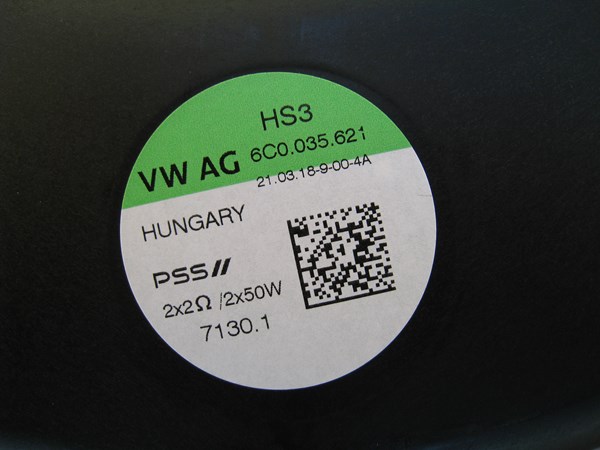
The amp although hidden under the passenger seat, has a nice informative label on the front. Although we didn’t take the unit out for further inspection, technophiles will be happy to know it’s manufactured by Panasonic in Slovakia and seems to be shared across other VAG cars. A quick Google search shows the PN9 SLU (5Q6 035 456) unit has been around for a few years and there are numerous second hand units available on-line.
There’s a nifty balance/fader feature that’s actually akin to a target ‘crosshair’ in which the target can be positioned anywhere across the six internal speakers giving a multitude of possible combinations.
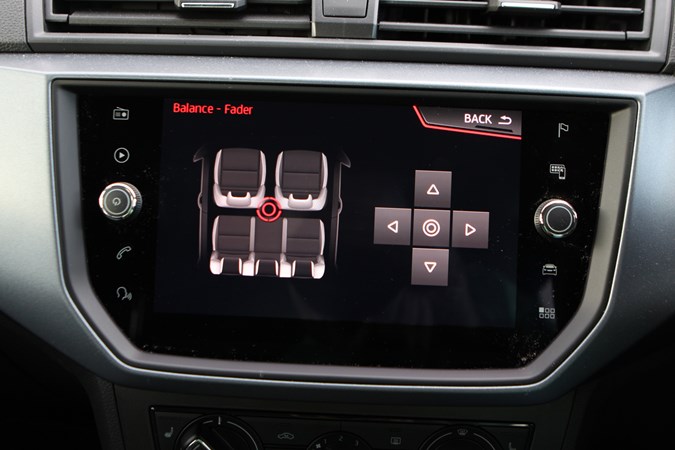
So what’s it like in practice?
Given that Dr Dre’s main genres are ‘hip-hop’ and ‘gangsta rap’; that means heaps of bottom end, some dipped mids and high frequencies that are slightly sibilant.
Tub-thumping bass
Beats kicks out the bass frequencies with a healthy tub-thumping throb and there’s plenty of rumble and lots of pumping mid-bass slam, too. That’s not saying the system is refined. It’s a question of quantity over quality.
Even so, the mids seemed slightly over generous and on all the test tracks I played as I found myself dipping the mid-range sometimes by 5db to make it sound more neutral. Given that the Arona is somewhat on the small side, the separation between the channels was just about adequate but nothing more.
In the early days Dr. Dre said that “Man, it’s one thing that people steal my music. It’s another thing to destroy the feeling of what I’ve worked on.” A comment that related to the many cheap and nasty sound systems (and dreadful headphones) that destroyed the total feel of the music that the artist had produced. I must admit I agree with him to some degree. There were many systems where they were just badly EQ’d, badly compressed or just plain bad – sounding thin, washy with no substance or soul.

So what happens when we use the on-board settings to ‘EQ’ the system?
Selecting ‘Equaliser’ from the set-up menu reveals a three-band graphic equaliser. This where the electronic EQ comes in and on the face of it looked like a standard three-band graphic (Bass, Mid and Treble) which would change the output of the DSP.
The graphic also controls the bass from the sub as there is no separate control for the output level of the sub-woofer. An individual level control for the sub would have been useful as I found on some occasions it felt narrow in frequency response.
The location of the sub is quite a clever affair being mounted inside the space-saver spare wheel. It’s a novel idea because you get the bottom-end frequencies of a discrete subwoofer without having to sacrifice any additional boot space.
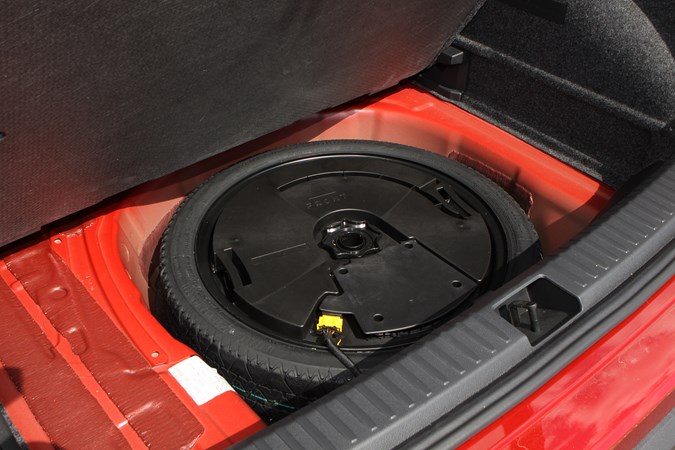
Some tracks appeared rather thin (even when the bass was cranked up) and I had to check that the sub was actually working as the output seemed quite low. In contrast, a Radio 2 newsreader shook the car. The sub was obviously doing the job but was fairly picky in the frequencies that it handled. Unfortunately we don’t have any technical data on the range it covered but it looked to be rolling off quite high.
The three-band EQ did not offer any pre-set frequencies so all controls were manual. On a personal view I thought that using only three bands was somewhat limiting and five would be more in line and giving more user control.
Unfortunately there was no indication of the frequency range of the three bands and what the frequency crossover point was at the zero db setting on each band.
Each band is labelled +9 to -9 so we are presuming this is the amount of db in boost or cut for each one although no data exists to confirm the settings in any of the user manuals.
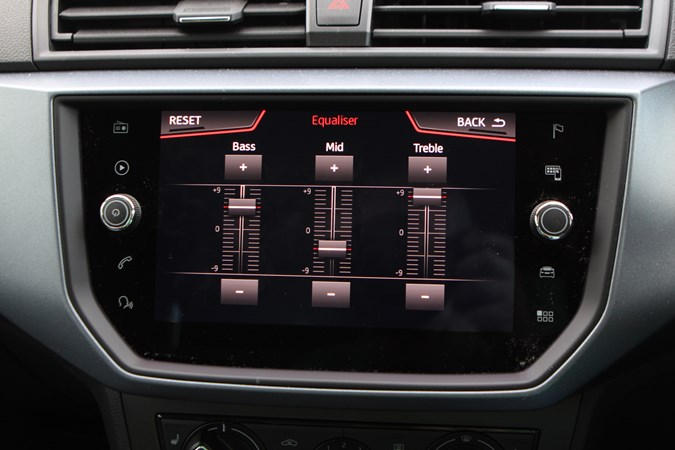
When you look more closely at Beats, the system seems to be in a similar vein to Bose where electronics and EQ algorithms are at the heart of the system. This effectively reshapes the sound which is in direct contrast to that of the purist audiophile where good faithful reproduction based more around physical hardware attributes is the order of the day.
All of this however is pretty subjective. I always think that you like to hear a similar sound quality to what you’d hear at home on your own hi-fi. I like a nice round and smooth bottom end with crisp highs and a neutral mid-range. But put an audio system in the car and you have to take in all that external road noise and a less than adequate sound stage and the like so it’s certainly not an ‘apples to apples’ comparison.
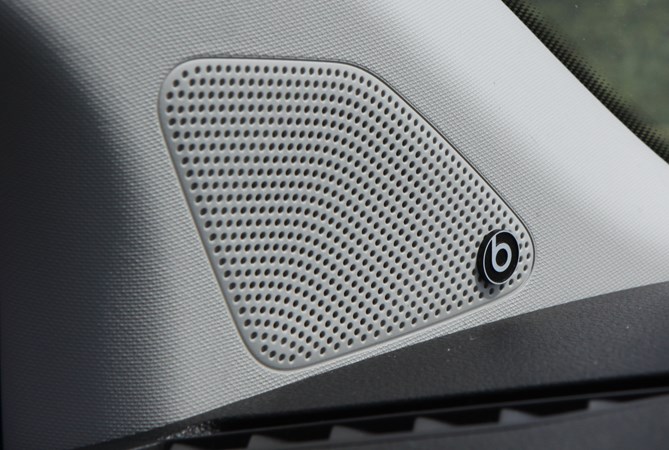
To give an idea of the settings used, I picked a handful of .mp3s. These were recorded at home using a good fast processor and an old (but very useful) copy of Syntrillium’s ‘Cool Edit Pro’ from the 90s (now Adobe Audition).
They were recorded from original CDs at a max bandwidth of 320kb/s for best possible reproduction with no gain on any channels (flat all-round). After inserting the memory stick to the on-board USB port, the Arona immediately recognised it and started off the first track.
The first track was an old favourite ‘Bad Moon Rising by Creedence Clearwater Revival’.This would be good for starters as it would be a digitally remastered version from late 1969.
I didn’t expect too much but was surprised that the bass didn’t seem to hog the set. The mids (as with all the tracks I tried) seem overly lively but in a quite narrow frequency band. The tops were good but not overly brilliant. First impressions were good for an in-car setup.
Next track was a person who I’ve seen live. Enya’s ‘Caribbean Blue’ sounded pretty good especially given the Beats system gives the mids quite a punch even with zero gain. The bass was nice and round at around 5db and the extra sibilance of the highs at 9db produced quite a nice sounding track.
Again I found that dropping the mids by 4-5db gave it a more natural sound, especially with the clean purity of Enya’s voice. This is typical of the style with Enya/Clannad having plenty of layered acoustic vocals (producing the enhanced cathedral-like reverbs and echos) in the track.
Cathy Dennis’s ‘Too Many Walls’ album gave a slightly muted bottom end but too much mid-range. Again I found myself ditching any gain on the mids and pitching it towards a negative reading. Tops were nice but in all, the track sounded rather thin and lacking substance.
On the flip side, I grabbed an .mp3 of my original 12″ vinyl release of ‘Rappers Delight by the Sugarhill Gang’ which was a club classic sampling ‘Chic’s – ‘Good Times’ from 1979. Apart from a few pops and clicks from over use in alcohol smoke infused night clubs, it had a big bottom-end, dipped mids and a slightly briliant top – just how Dr. Dre had prescribed.
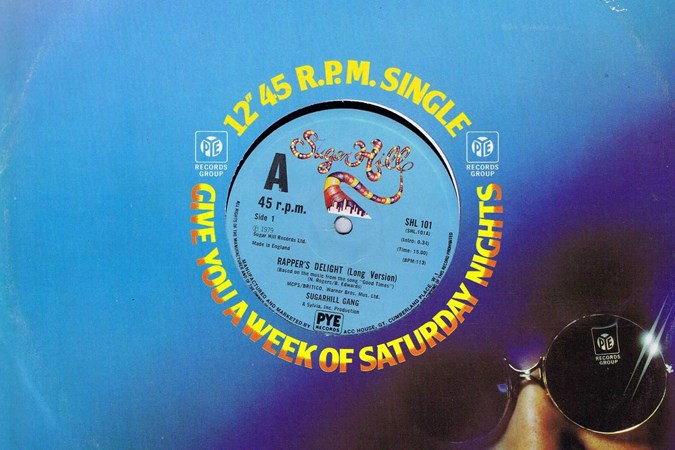
Various other tracks were played and a pattern began to emerge. Even on a three-band EQ, the classic ‘Smiley Face V’ curve seems to fit the majority of tracks although Toto’s ‘Africa’ brought the bass back into play and certainly made the whole car shake.
I did find that the frequency response of each EQ band different to what I’d imagined. The response from the sub was a bit of a lottery and the feeling was that it rolled off at the bottom end possibly around 200-300 Hz which felt quite high. On some tracks it actually appeared quite thin. On others it was not the case.
The mids felt quite narrow and ‘Toppy’ (maybe up to around 3-4 kHz) but heavily punchy when pushed into a positive reading. The top didn’t extend quite to where I’d like. It seemed to roll off quite early at what seemed to be around the 12-13 kHz area.
When pushing the unit quite hard the amount of distortion seemed really low so hats off to some nifty electronic work in the DSP.
Sade’s ‘Diamond Light’ soulful 80s album tracks could easily be pushed to 90% with minimal degradation and I thought it EQ’d quite well. On most tracks mid-bass slam was quite heavy but this suited the style of music somewhat.
A quick change over to Radio 3 produced a somewhat unnatural sound. Everything seemed muddled. I think classical aficionados would have some comments to make, but this system is not really aimed at this audience.
I’d image that if you were playing hip-hop then Beats Audio makes it sound great. For orchestral music, in contrast, it doesn’t do much.
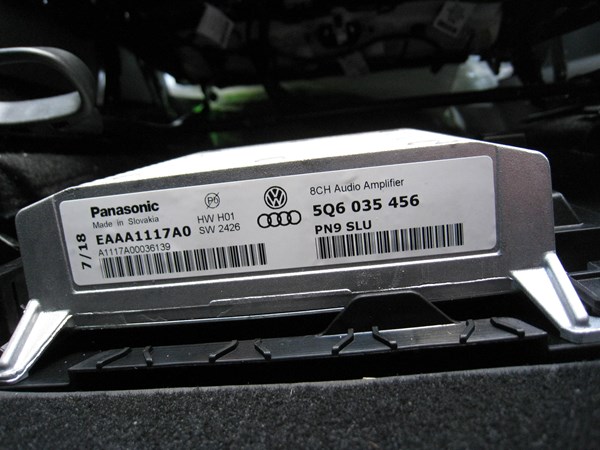
Overall the system handled most things played although it’s not really a high league player. Even so, for what is was, it sounded reasonably good for pure mobile entertainment and did the job required although it seems to be tailored towards a younger crowd.
Roundup – the good bits and what we like
- Low distortion, good DSP
- You can run it quite hard and still talk in the car
- Bass can sometimes be quite smooth
- Mid bass slam works well on some tracks
- Sub in the boot – nice thought out location
On the other hand what didn’t quite hit the mark
- Mediocre channel separation
- Mid-range seems narrow and overly gained
- No individual control over the sub-woofer gain
- Only three channels of EQ
- Sub feels limited with the low frequencies that it handles
Update 7: So you want one now! – If you fancy buying a brand new ARONA
So you want one now – here we’ll show you how to get your hands on a brand new SEAT ARONA
Okay – we’ve whetted your appetite with our new baby SUV. So now we’ll navigate through the various finance options giving you some pointers on what the outlay will be. As we’re always impartial, we’ve selected some alternatives to the Arona to give you a fair comparison against some of its rivals.
However, finance is just one of many options which helps you to get your hands on some new metal. So if you’ve not got £20k hidden under the bed or scooped the lottery, then a personal loan may be another popular option. Ultimately you will own the car and there are no mileage restrictions – so it’s an option that’s always worth considering.
On the flip-side there are many tempting monthly PCP and PCH finance options. If you’re in the dark about some of the finance jargon, then see further down this article as we get the assistance and expert help of the Parkers Finance Editor, Christofer Lloyd.

Personal Loan
CAR: SEAT Arona SE Technology Lux 1.6 TDI 115PS*
Typical personal loan example: Tesco Bank, £20,500 over five years.
APR 3.1%
60 monthly repayments: £367.98
Total repayable £22,078
Cash price £20,455
Tesco loan information here
PCP Monthly Finance
CAR: SEAT Arona SE Technology Lux 1.6 TDI 115PS*
Loan period: 36 months
Monthly payment: £248.92
Annual mileage: 10,000 miles
Customer deposit: £2,000
Manufacturer deposit contribution: £0
Typical APR: 0%
On-the-Road cash price: £20,455
Total amount payable: £20,455
Check out the latest deals here with SEAT
Let’s compare a similar PCP deal if you decided to purchase the nearest petrol equivalent
PCP Monthly Finance
CAR: SEAT Arona FR 1.0 TSI 115PS*
Loan period: 36 months
Monthly payment: £263.70
Annual mileage: 10,000 miles
Customer deposit: £2,000
Manufacturer deposit contribution: £0
Typical APR: 0%
On-the-Road cash price: £20,165
Total amount payable: £20,165
Check out the latest deals here with SEAT
So, we’ve initially looked at a few options to purchase a brand new Arona, but what about its rivals? The Arona sits squarely in a pretty tough market. It’s an extremely competitive busy sector and the opposition are equally as keen to get their hands on your hard-earned cash.
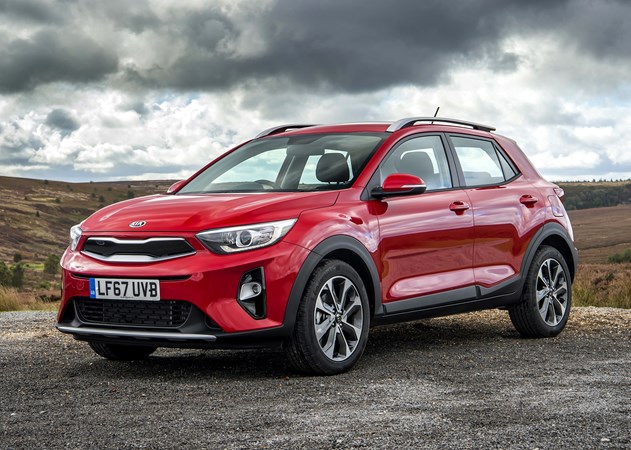
Personal Loan
CAR: KIA Stonic ‘3’ 1.6 CRDi 113bhp 6-speed manual*
Typical personal loan example: John Lewis Finance, £19,300 over five years.
APR 5.0%.
60 monthly repayments: £362.93
Total repayable £21,776
Cash price £19,300
John Lewis loan information here
PCP Monthly Finance
CAR: KIA Stonic ‘3’ 1.6 CRDi 113bhp 6-speed manual*
Loan period: 36 months
Monthly payment: £291
Annual mileage: 10,000 miles
Customer deposit: £2,000
Manufacturer deposit contribution: £1750
APR: 5.9%
On the road cash price: £19,300
Total amount payable: £21,324
Check out the latest deals here with Kia
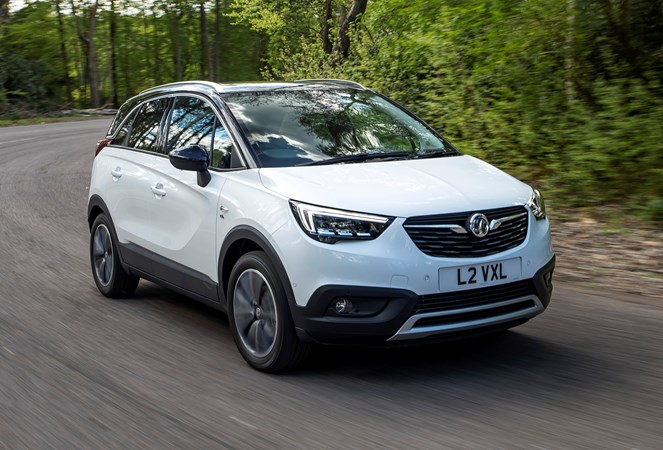
Personal Loan
CAR: Vauxhall Crossland X 5-Door Tech Line NAV*
Typical personal loan example: ASDA money, £19,500 over five years.
APR 2.8%.
60 monthly repayments: £348.35
Total repayable £20,901
Cash price £19,690
Asda loan information here
PCP Monthly Finance
CAR: Vauxhall Crossland X 5-Door Tech Line NAV*
Loan period: 37 months
Monthly payment: £319
Annual mileage: 10,000 miles
Customer deposit: £2,000
Manufacturer deposit contribution: £0
APR: 2.9%
On the road cash price: £19,690
Total amount payable: £20,798
Check out the latest deals here with Vauxhall
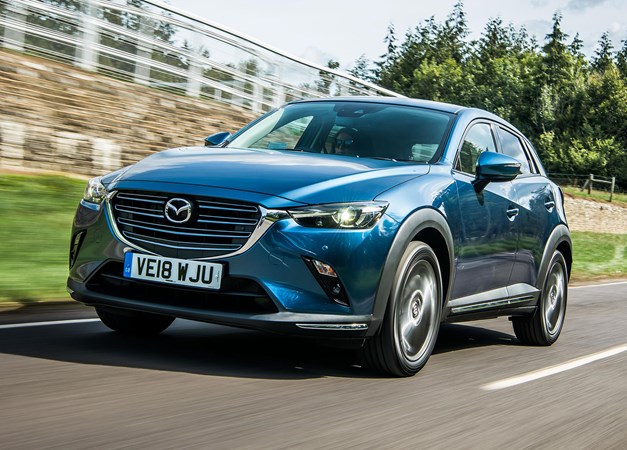
Personal Loan (Typical poor high APR )
CAR: Mazda CX-3 Sport Nav+ 115PS*
Typical personal loan example: M&S money, £23,000 over 5 years.
APR 6.7%.
60 monthly repayments: £450
Total repayable £27,003
Cash price £22,895
M&S loan information here
Personal Loan (Typical good low APR )
CAR: Mazda CX-3 Sport Nav+ 115PS*
Typical personal loan example: ADSA money, £23,000 over 5 years.
APR 2.8%.
60 monthly repayments: £411
Total repayable £24,652
Cash price £22,895
Asda loan information here
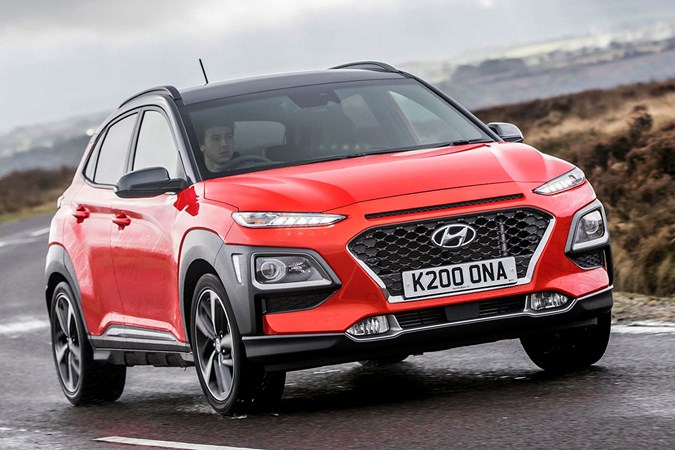
Personal Loan
CAR: Hyundai KONA SE 1.6 115PS Diesel 2WD Manual*
Typical personal loan example: ASDA money, £20,000 over five years.
APR 2.8%.
60 monthly repayments: £357.28
Total repayable £21,437
Cash price £19,690
Asda loan information here
PCP Monthly Finance
CAR: Hyundai KONA SE 1.6 115PS Diesel 2WD Manual*
Loan period: 37 months
Monthly payment: £328
Annual mileage: 10,000 miles
Customer deposit: £2,000
Manufacturer deposit contribution: £1250
APR: 5.9%
On the road cash price: £19,900
Total amount payable: £22,012
Check out the latest deals here with Hyundai
Conclusion:
The ARONA makes a great PCP deal given SEAT’s current 0% APR finance offer. The monthly repayments are low and you’re paying nothing in interest charges. You also have the option to keep the car after the 36 month period. If you decide on this route then the final payment of £9742 makes for a good all-round proposition. Pay this and the car is yours.
Parkers Top Tips
Read and check the financial small print with a fine toothcomb.
Remember, apart from possible penalties for late payments, some lenders may also hit you with a penalty for repaying your loan early so we’d say always read the loan small print before proceeding and double-check that the product is suitable for you.
Get the lowest APR charges
The loans shown above are just a small selection from various online finance calculators sourced on October 30th 2018. APR rates differ with the amount of money you borrow. Loan rates and particularly the APR charges can and do change frequently – so our advice is to shop around in order to get the lowest charges.
Currently we’re seeing ASDA money offering a great low APR of only 2.8%. A loan of £23,000 over 5 years means you’re saving nearly £40 per month in interest charges when comparing to the higher rate of 6.7% (Marks and Spencer finance for example) so as always we say check for the lowest APR.
Get the best deal
Have you got £20,000 hidden away? If so then nip down to your local SEAT dealer and smile at them nicely. Do some friendly bartering and grab a great deal on the day. You should be able to negotiate a good discount as a buyer with ‘Cash Waiting’.
Is there a best time to buy?
Buying towards the end of the month can be a good idea as dealers work hard to meet monthly sales quotas. Additional deals and incentives not available at other times can also come into play. In some cases, salespeople have bonuses if they hit their targets so dealers are generally keen to move metal towards the month end if there’s been any shortfall or sales have been slow.
Understanding car finance and avoid the pitfalls
Read through our expert finance tips here complied by Parkers Finance Editor, Christofer Lloyd.
https://www.parkers.co.uk/car-finance/advice/
https://www.parkers.co.uk/car-finance/advice/2016/car-finance-explained-what-is-pcp/
More reading – Parkers Dealwatch
Grab the best PCP and PCH deals (updated monthly).
https://www.parkers.co.uk/car-buying/deal-watch/
*Deals are correct at time of publication. Everyone’s financial circumstances are different and credit is not always available – Parkers cannot recommend a deal for you specifically. These deals are indicative examples of some packages available this week.
Update 8: ‘Real world driving – pistols at dawn’ – a brief dual between two rivals
This week we’ve had the use of a new Kia Stonic on the Parkers fleet for a short period. What makes this pertinent is that as well as being one of the Arona’s rivals, it was also fitted with the 1.6 CRDi 116bhp diesel engine, so putting it head-to-head with our 1.6TDi Arona made perfect sense. Whilst it’s not a full out-and-out comparison, I’ve picked some interesting areas that potential buyers could consider important. So take a back seat and see what we have gleaned between the two.
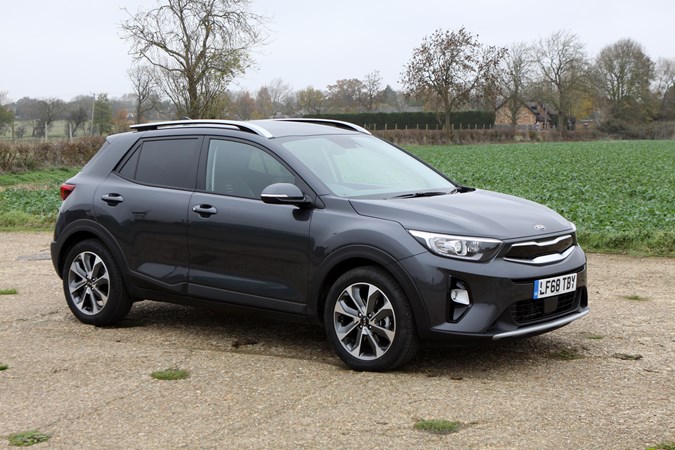
Engines and powertrains.
Although on paper the figures look similar, it’s a bit of a chalk-and-cheese scenario when it comes to the engines. The Arona’s 1.6 TDI unit, although extremely refined and quiet, seems to lack much in the way of punch lower down the rev range. It’s a higher-revving engine with more torque further up in the range, redlining at 5,000rpm.
In contrast, the Stonic has a huge (and we mean quite substantial), 171Nm burst of torque between a very low 1,500 rpm, stretching up to 2,750 rpm and maxing out at 280Nm; making it very easy going. It actually feels more powerful than the claimed 115hp.
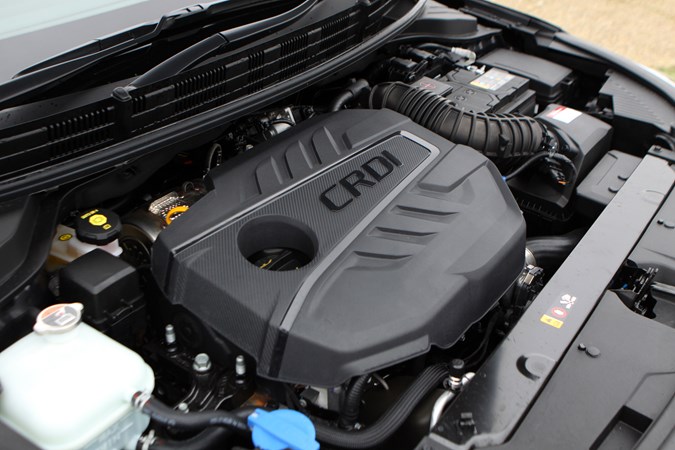
Although the Stonic does sound a little more agricultural than its rival on start-up, it’s a great power unit and bucks the trend of my fellow reviewers who prefer the petrol engine variants. I personally like it and found it really easy to live with.
Infotainment system
The Arona SE Lux is fitted with a clear and concise large 8.0-inch infotainment system. It looks good and the screen has a nice crisp resolution. It’s great to use and the software is very intuitive.
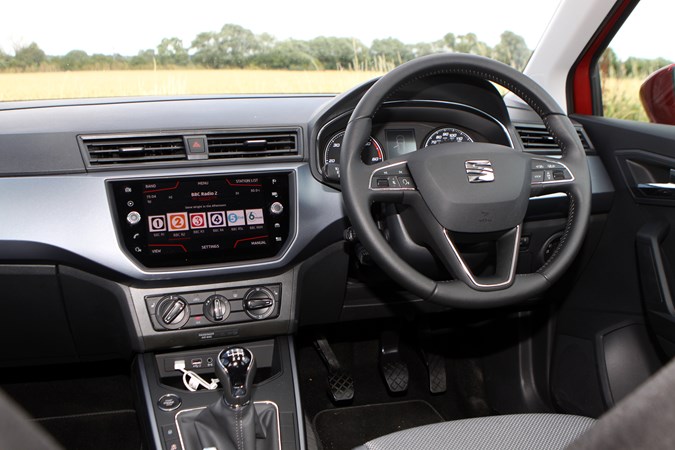
The Stonic’s slightly smaller 7.0-inch unit doesn’t have quite the ‘wow’ factor of the Arona. It’s functional and the graphics are neatly designed with quite modern fonts without looking too blocky, but we do feel that the smaller screen loses out on this occasion.
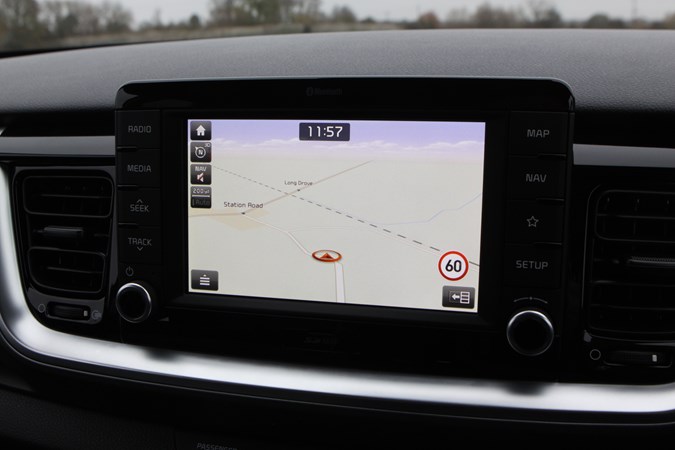
Night driving and lighting.
The Arona’s headlamps are generally good all-round performers. However, as I make my homeward journey from the office across dark country roads, I’m finding the high-beam somewhat subdued. From a driver’s point-of-view, it seems to add only a little bit extra to the distance and nothing really to the mid-field of view. On the contrary, the Stonic’s normal ‘dipped’ beam is quite intense.
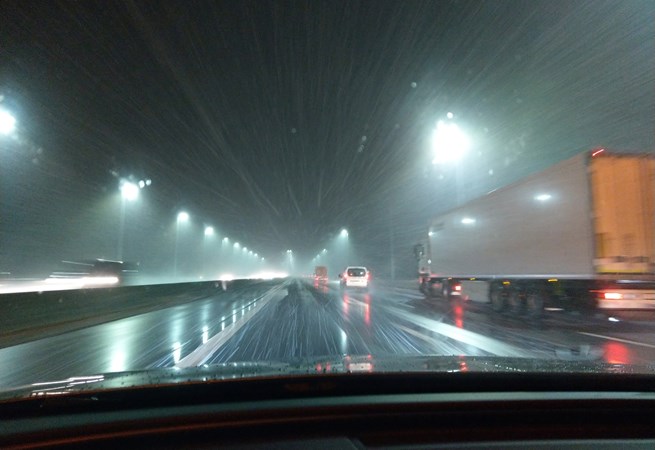
There is certainly a perceived improvement over the Arona and on full-beam the forward field extension is quite pronounced giving an excellent field of view. It seems to be performing better but without dazzling any incoming traffic at the same time.

Additionally, both cars are fitted with active side driving lights which come into play should the vehicle negotiate a corner. Both operate well but we found Stonic had better on/off control. Testing on three bends of varying degrees, the Arona failed to light on all three. Only on a solid 90-degree turn onto my driveway did the lights function. In contrast, the Stonic lit the curbs on all three bends when cruising through a poorly-lit winding village. It did a great job.
Handling
Despite being a smaller SUV, the Arona still has more of an ‘SUV’ feel about it. While the handling is generally good, we do notice some induced body rolls when travelling quickly into corners and uneven surfaces. Saying that, it’s a positive experience with the on-board ESC and ABS combination and at no time has the car ever really felt that it would get out of shape.
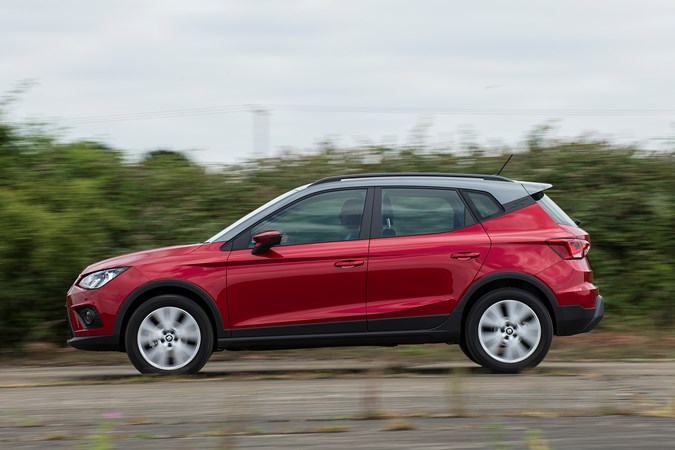
In contrast, the Stonic has much firmer feel on the road – more akin to a hot-hatch. When on board you actually don’t feel like you’re in an SUV. As the diesel engine picks up very rapidly from low down in the rev range, you can put the car through corners at quite a pace. The stiffer suspension does give rather more feedback into the cabin, but overall it’s a good, pleasing and positive ride.
Boot/load space
Readers following our Arona from the start of our long-term review would have seen how much luggage we managed to cram into it on our trip to Cornwall. The Arona has a great boot size, which is made even larger as the boot floor can be lowered further to increase storage over and above the norm. For its size at 400-litres, it’s pretty cavernous.
Lift the boot of the Stonic and because it looks and feels rather more like a hatchback (it’s actually based around the Kia Rio), it struggles to compete with the Arona on space. It’s good at being able to get a couple of medium cases in, but at 352-litres – not much more.

Fuel Economy
As we’d only had the Stonic for a few days, we could only do a couple of part-refuels, but from the data we gleaned at the time, the car seemed to be returning around 62mpg combined. This is about 87% of the manufacturer claimed 70.6 miles per gallon, which we thought was a pretty reasonable real-world performance.
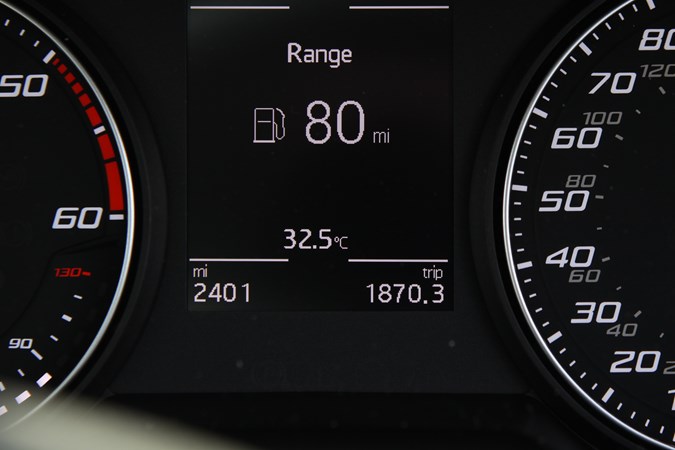
Unfortunately the Arona has always struggled right from the start to get into a comfortable area. The manufacturers claimed 68.9 mpg has never been on the horizon. We’ve refilled the car on many occasions and with different drivers behind the wheel, but on average we’re returning around 49.7mpg combined in the real-world – which is approximately 72% of its claimed figure.
Any ‘true 4x4’ options?
Unfortunately neither of our contenders offers any true 4x4 experiences; both have purely two-wheel drive powertrains and are more akin to road-going SUV’s offering style over functionality. The word is that customers who are shopping in this segment are not really off-road aficionados, but are looking for a hatchback with a little more space, improved visibility and a different design appeal. Buyers wanting 4WD capability in the SEAT range should look more towards the ‘Ateca’ and in the Kia range, the ‘Sportage’.
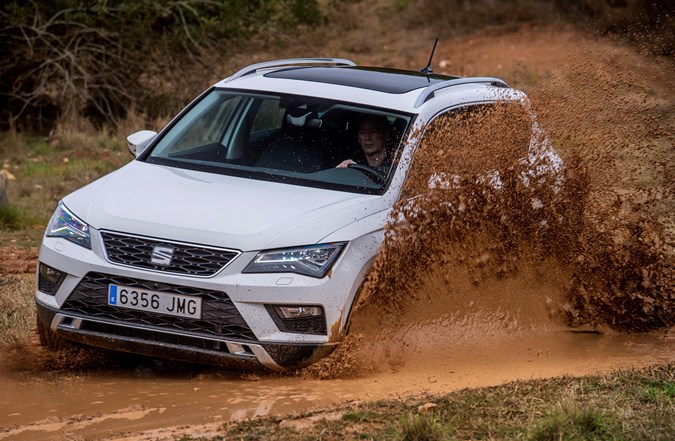
Warranties and aftersales care
When you buy your new SEAT from a franchised dealership, your new car is covered by a standard three year/60,000 mile warranty which can be optionally extended to four years/75,000 miles for an additional £185, or to five years/90,000 miles for an additional £324. Both basic and extended warranties are fully transferable should you decide to sell the car.
In common with all Kias, the Stonic has probably the best warranty in the business – a seven-year/100,000-mile covering all labour and parts, except those subject to normal wear and tear. The warranty is transferable if the car is sold before the time/mileage limit expires.
The Stonic is available with ‘Kia Care’ service plans, which have been developed to provide customers with a wide range of service plan options for any Kia model within the first seven years. A customer can now purchase services up to and including the seventh service which matches the full length of the warranty.
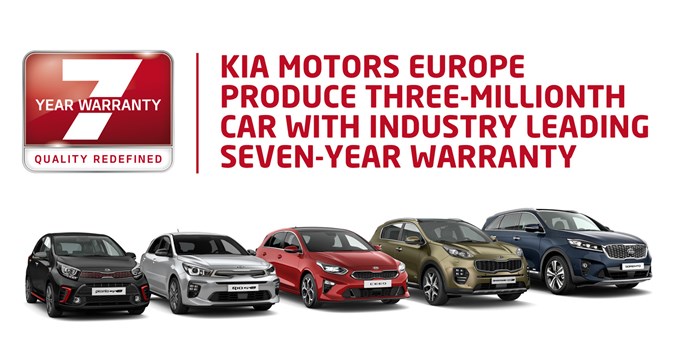
Update 9: Infotainment and media system
If there’s something that we love about the Arona, it’s the extremely intuitive media and navigation system. The Arona SE Lux is fitted with a large 8.0-inch infotainment system. It looks good with a nice crisp resolution and uses a capacitive touch screen that is very responsive. When you turn on the unit for the first time, the user can pre-set all the basic functions using the ‘configuration wizard’.

The user is presented with a top-level menu system consisting of ten mini sub-menus, which are easy and straightforward to navigate through. You’ll notice also that the unit is fitted with a proximity sensor so as soon as your hand gets close to the screen, the menus and borders are removed and the screen shows what could be described as ‘full screen’ mode. Cool and we like it!
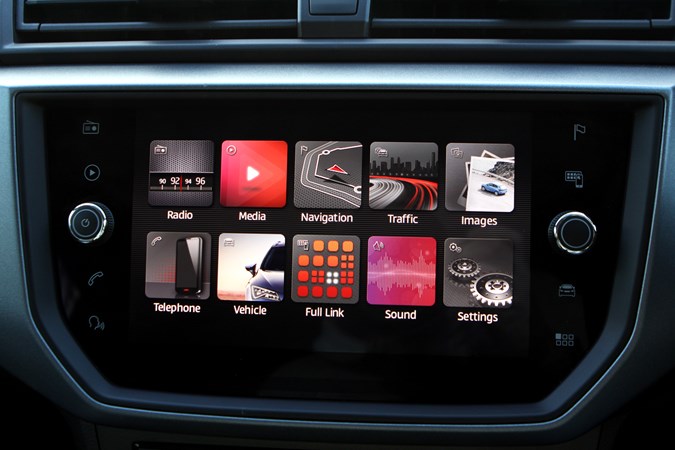
Starting on the top-left, selecting the ‘radio’ sub menu displays the current stored radio stations. Within this sub menu, the user is presented with additional menus in each corner, rather like a parent/child arrangement, however some sub menus are split further down the tree.

On the top left, you have the ‘band’ selector choice of AM/FM or DAB. The ‘station list’ shows all currently stored stations and the ‘sounds’ menu is a duplicate of the Sounds menu on the main screen. Here the manufacturer has wisely given the user a quick link to adjust audio direct from the radio menu without going back a step further to the main screen. Additionally users can also adjust the volume and other ‘sound’ related options such as the three-band graphic equaliser direct from the sub-menu.
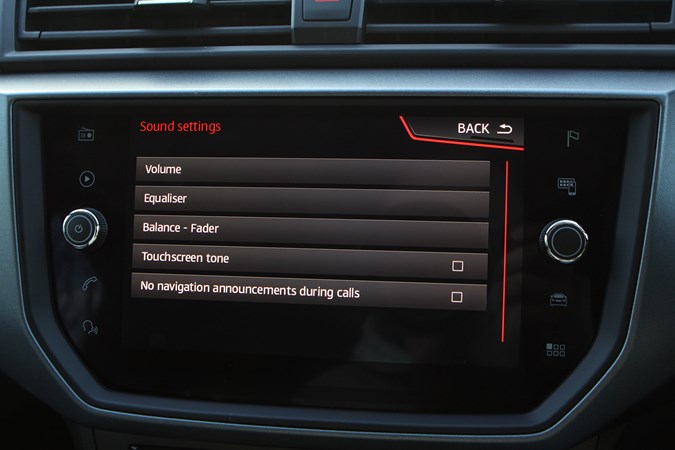
It’s all very easy when you get used to the simplistic way the menus work and if you do get stuck, you can always hit the icon on the bottom right of the screen which will take you back to the home screen.
Moving along the menu bar, we are now looking specifically at the ‘media’ menu. As you can see, before anything happens you need to select the source where your file is stored. In the image below we’re using a USB memory stick stored with a handful of mp3 music files, which is plugged into one of two on-board USB ports behind the gear lever.
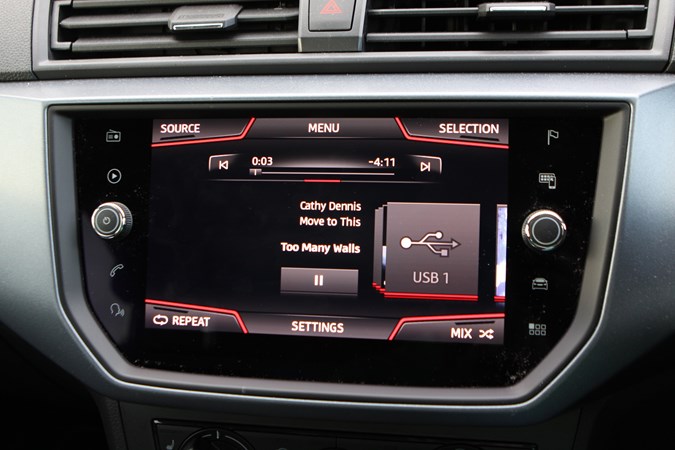
The source can be changed easily via the sub-menu and the Arona has a variety of different audio sources available.
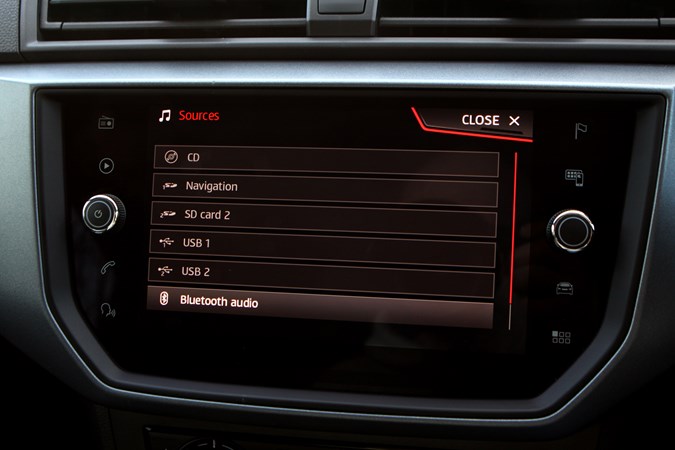
The next menu option is navigation and because this is more involved, we’ll treat this as an update in its own right. On the next update we’ll guide you through the various menus showing how you can input navigation data and get from ‘A’ to ‘B’ with ease.
The Arona’s infotainment system also includes a nifty traffic conditions screen. Being held up because of an accident or other road issues can cost you time, but having different options (such as detours) gives the user a heads up on routes to avoid.
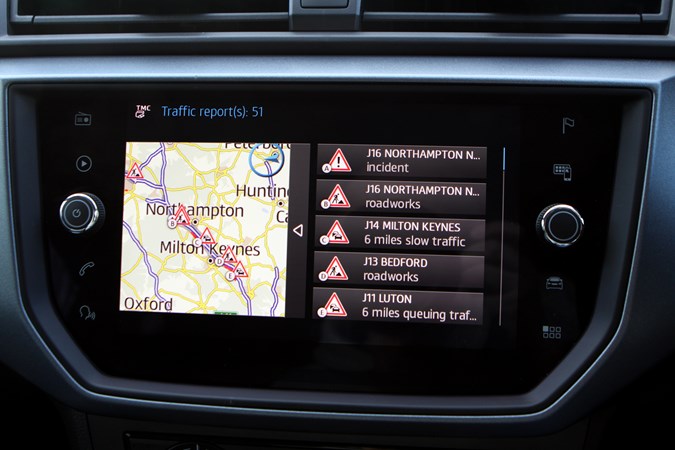
Once the problem area has been identified, you can then select the screen which gives you further information on the incident and additionally, any alternative route can be selected and transferred directly into the navigation screen in a matter of seconds. It’s great, works extremely well and gets a big thumbs up for usefulness.
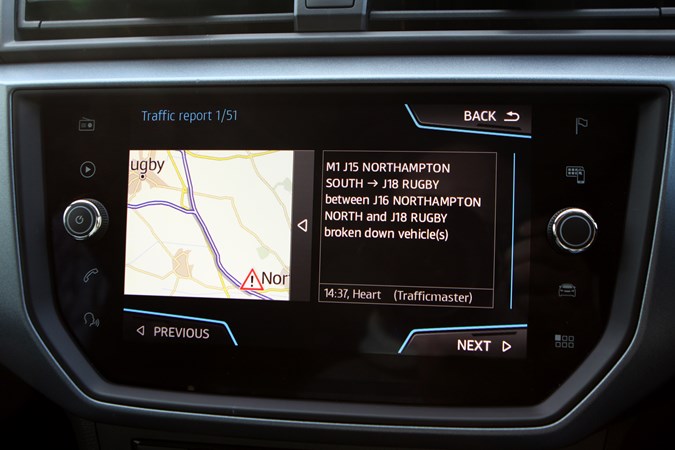
One menu screen that is quite a funky addition to the mix is the ability to store digital images. After selecting the image source, any stored image can then be viewed individually or run in a slide-show mode which has sub settings in its own right.
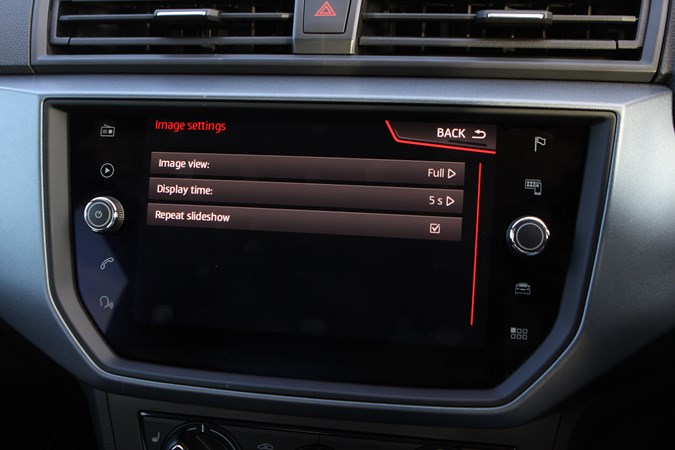
Moving now to the bottom row of menu items, one important feature is how a mobile device is paired to the car. Here the user can enable Bluetooth on their mobile device and the car will search for it in order to be paired. Once paired, the device will work seamlessly with the on-board controls and menus.
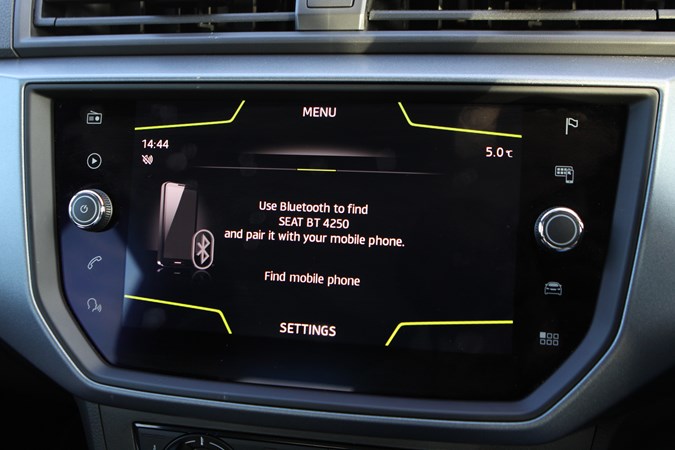
The vehicle status menu is a comprehensive run-down on current in-car settings. These include an Eco Trainer and vehicle and driving data.
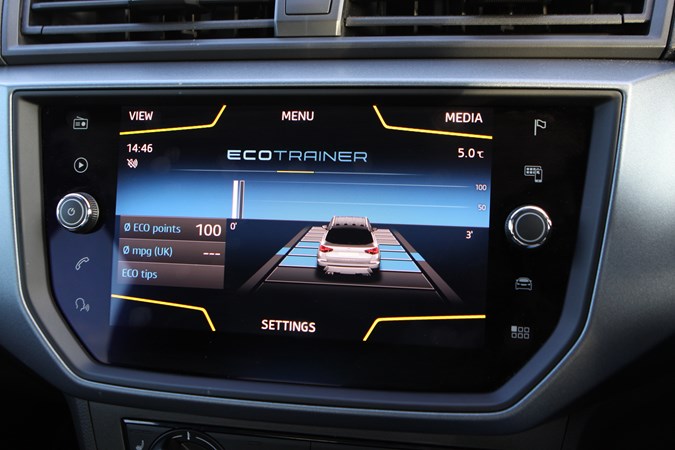
For uses who want full connectivity between the car and their mobile device, then SEAT’s ‘Full Link’ will be one menu item that they will enjoy visiting. The opening screen shows that users can select either ‘Android Auto, Apple CarPlay or MirrorLink’ depending on their device. For those wanting to know more on each system and a concise rundown of how each one operates, click on the links above.
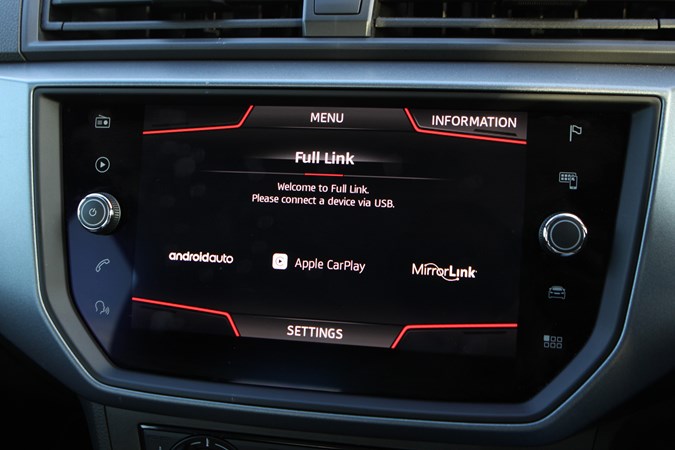
The user can also scan the on-screen ‘QR code’ which will connect their mobile device to SEATs website for a full rundown on how the FullLink system operates.

Penultimately, the sound sub menu offers the user controls of the audio output including the balance, fader and graphic equaliser.
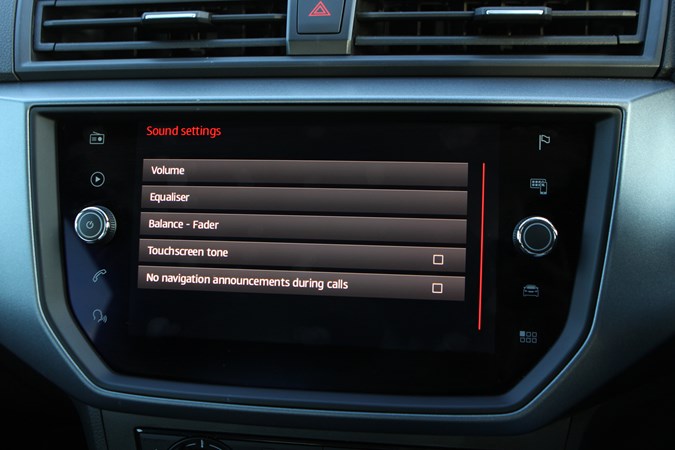
And finally, the ‘settings’ sub-menu gives the user control of the screen, time and date, languages, units and any data transfer for SEAT apps.
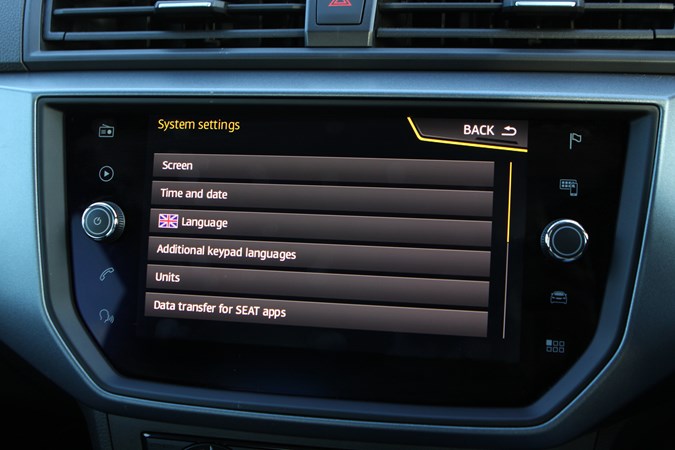
As a closing curtain on this update, there are a couple of screens that we feel are useful to the driver. First is the excellent on-board feature when the car is running low on fuel. By default the car flags up a ‘fuel low’ warning when the car has an indicated of 60 miles remaining. The user can then allow the system to find a suitable filling station. Normally the system will put fuel stations in order of distance.
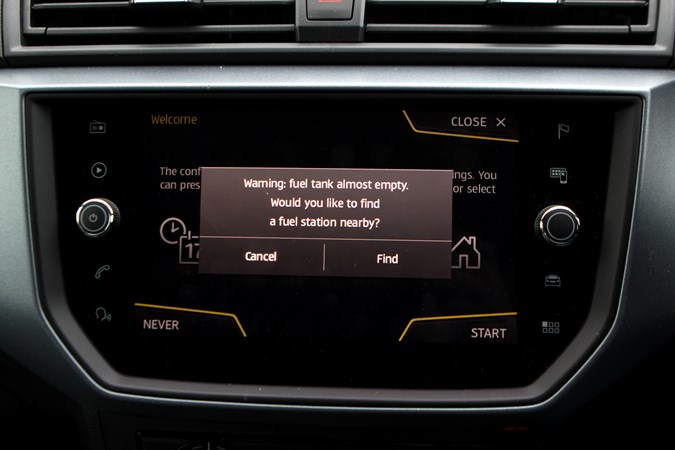
When you select the chosen filling station, you will be prompted by the on-board navigation system if you would like directions. These are then put straight on to the navigation screen making it a very intuitive and seamless exercise. It gets our vote as being mega-useful.
There’s also a voice control screen where the driver can setup their own preferences when using voice control. Some users can find on-board audio assistance to be distracting, others are opposite and find the prompts and outputted commands and data a useful contribution. Whatever way your preference, the small ‘voice’ icon on the bottom left-hand side on the main screen gives you all the control you need.
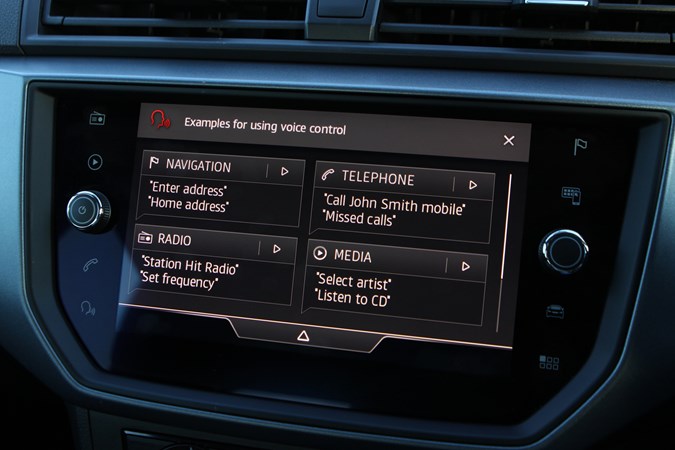
In conclusion, we feel the infotainment and in particular some of the features which are blended in with the navigation system have been extremely well thought out. There’s plenty of user input available but on the flipside the system offers the user some very nifty features making driving just that little bit more of a pleasure.
Update 10: Navigation system
If there’s something that we love about the Arona, it’s the great navigation system. There’s a bonus that you can also access the ‘Android auto’, ‘Apple Car Play’ or ‘Mirror Link’ apps if you wanted your smartphone to do the donkey work, but we found the on-board navigation more than easy to use with fast feedback and response.
It’s also a pertinent subject these days as the law is quite clear on the use of mobile phones especially when using your mobile as a sat-nav device.
If you get stopped by the police, you can’t say you’re simply following the map on your device and that’s why you’ve picked it up – they’re unlikely to be very impressed. Expect a £200 on-the-spot fine and six penalty points. The law specifically refers to this, which states that it is illegal to use a hand-held mobile to follow a map.
To use your smartphone as a navigation or a mapping device, you must fix the phone to the windscreen or dashboard, so it’s in clear view for use while driving (but not obstructing your view), without requiring you to hold it or physically interact with it.
So now we’re all legal, let’s get out on the road and see how the SEAT Arona’s navigation system performs in the real world.
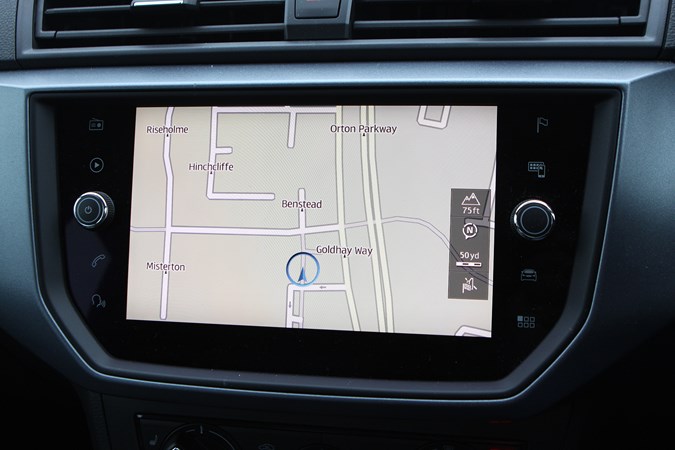
When turning on the navigation from the main menu screen, the system defaults to your current location. It also shows you certain features on the bottom right hand side of the screen, and highlights the current height above sea level (great for pilots and those enduring a run up a 12,000 foot mountain). North can be toggled to show true north or to use the direct of travel as a false north. The later helps when driving in that the map always faces the correct direction of travel which is useful. Try following a map when it’s facing 180 degrees ‘out-of-phase’ – it’s no fun and you’re guaranteed to mess up!
The third icon shows the map scale. This can be set using your fingers to scale the on screen map. For heavily built areas a scale of 50m is good as it shows better levels of detail. For motorway or fast road use, the scale could be set to 200m or more which gives the driver more advanced warning of junctions and exits.
What’s an additional bonus is that as the main nav screen does its job in showing the bigger picture, however there’s a sub screen directly in front of you on the main dash which gives a graphical indication of up and coming route changes. Both work well together in tandem and it’s generally accurate but I did find on one occasion that a ‘prompt’ to leave the M6 at a junction was wrong. Saying that, it seems to be correct 99% of the time.
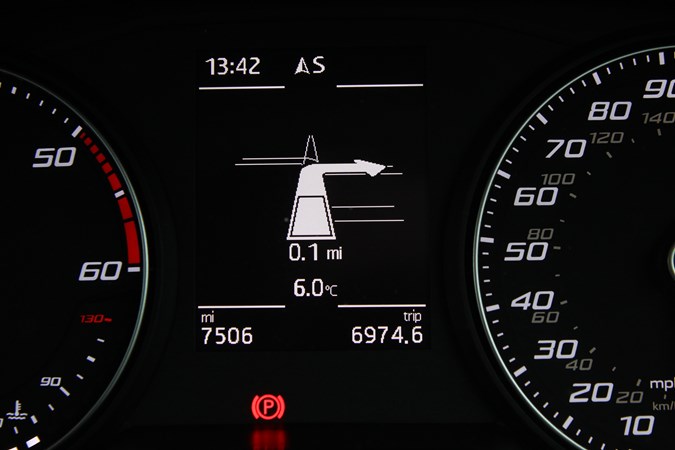
This gives you a run-down of getting started, so let’s look at the system in the real world. First you need to select a new destination and then enter the first details of the address. The unit performs well in this area with a predictive text/location function that on the whole works quite well. If you know the destination postcode, you can also search by this method so there’s more than one way to crack the nut.
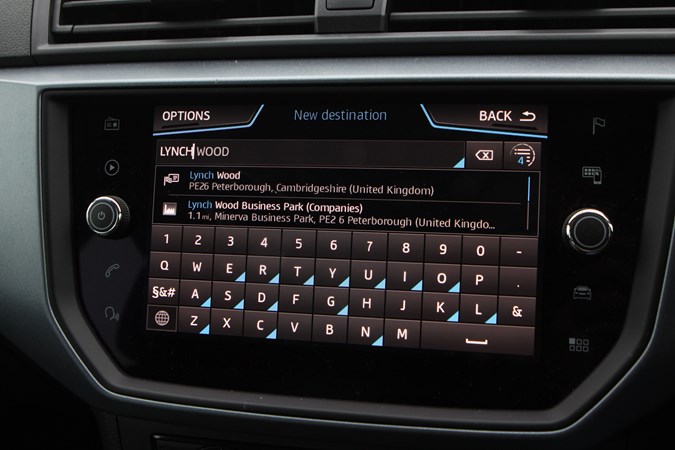
The system also gives you the option to store the destination (should you use some destinations frequently) and this saves having to re-enter the same details again in the future. When the destination is confirmed, the unit normally gives the user three routing options which vary depending on the current system settings.
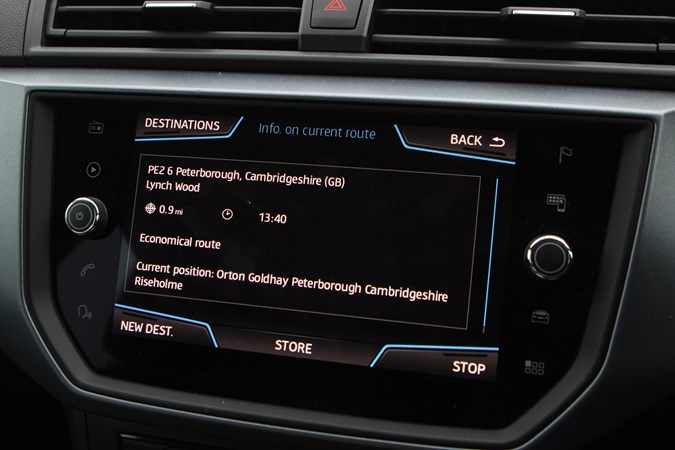
What is extremely useful is that once a route has been chosen, any traffic issues will be flagged so it gives you the chance to change the route before setting out. It’s a great feature and I found it worked very well in practice on more than one occasion. This is one area where the Arona’s navigation system excels as in addition, if you stumble upon a traffic problem en-route, the system will alert you and give you varying options to modify your route in advance which helps avoid any problems. These two combined powerful features make the unit a great mate to have on board. A big thumbs up here!
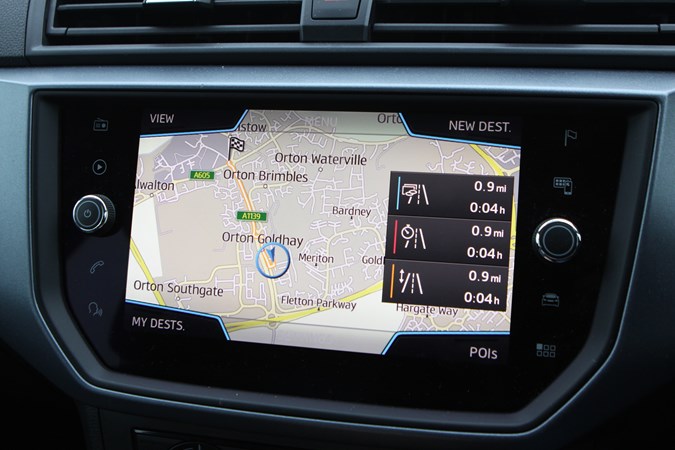
Once the route has been confirmed, a blue routing line appears on the map which shows a graphical interpretation of the intended route. When setting off, the route then flows in real-time so the driver can see exactly where they are and the intended route. Additionally using the on-screen direction prompts (as previously mentioned) make it simple to use.
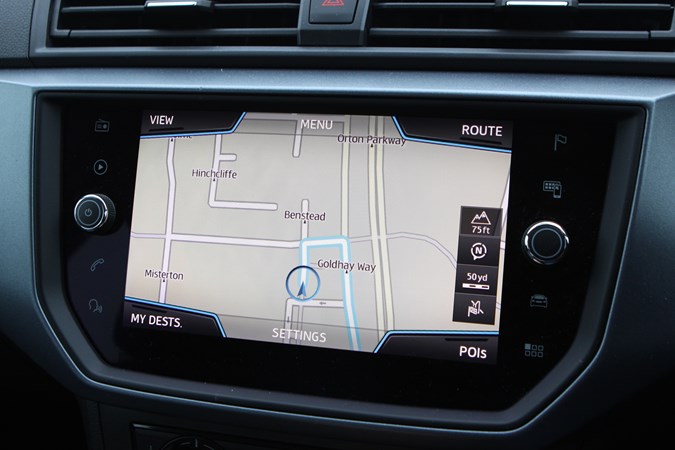
Digging a little deeper into the navigation, the menu offers the user various settings depending on user preferences. Route options such as ‘Avoiding Tolls’ is a popular choice especially when travelling on the continent (For info, EU is covered as standard so no need to go out buying upgraded maps).
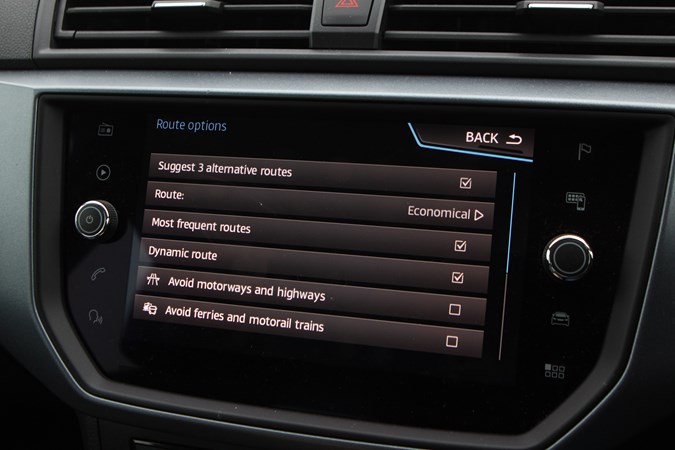
Other options include the most economical route. However I’ve always advocated that a feature which enables you to ‘Avoid City Center’ locations would be a good addition not just to this, but to other navigation units.
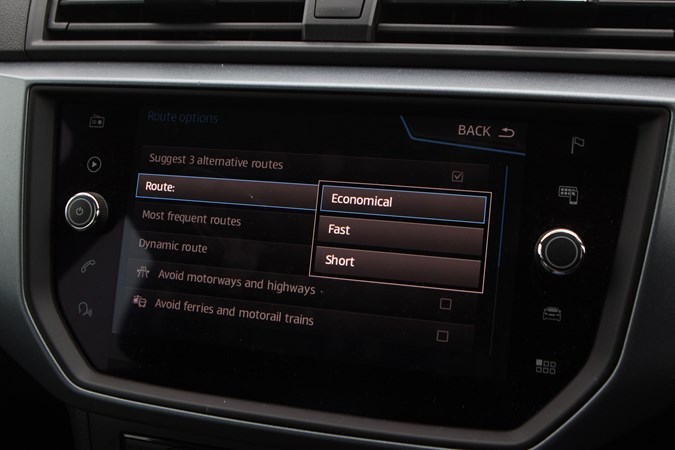
So everything has hopefully worked as planned and we’ve got to our destination. Now you want to look into how you have more control over the navigation system. There’s a plethora of screens all offering the user their own preferences from ‘map settings’ to ‘fuel station’ inclusions and exclusions.
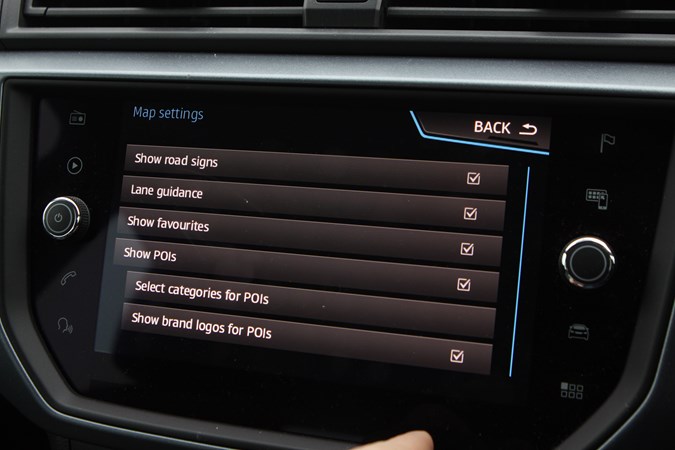
Some users may even think there’s too much information and an overly complicated interface. We’d disagree, as once you become accustomed to the many comprehensive features, we feel you’d find yourself short-changed being offered anything less.

In summary – it’s a great unit with a very comprehensive user friendly interface that’s easy to use. It works extremely well in real-world scenarios and rarely gets things wrong. We love the ‘alternative route’ functionality when road conditions change such as a blocked road because of an accident. It could save you hours of queuing.
Update 11: ACC (Adaptive cruise control) and Parking sensors
We all know that many of today’s cars are fitted with cruise control, but do you find yourself circumventing that little switch?. You know what is does (well sort of), but is it a case of you’re not 100% sure how to use it. Well for some SEAT Arona owners, we’ll dissect the adaptive cruise control and tell you all about how it works and how you can use it with confidence.
So what’s it all about? ACC (Adaptive Cruise Control) enables a more comfortable ride by using a front radar system which reacts automatically to the driving style selected by the driver, thus moderately accelerating and decelerating in the flow of traffic. The function is activated via a control lever on the left-hand side of the steering column.
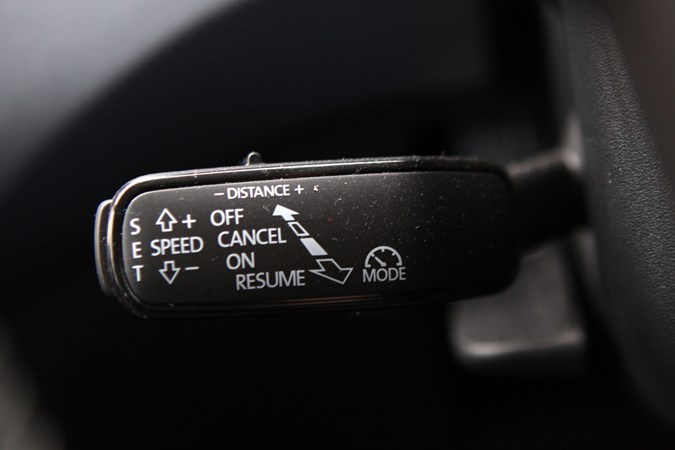
Once the driver has set their desired speed and the distance they want to keep from the vehicles in front, the Arona automatically regulates these factors as traffic conditions allow.
Yes it’s that simple and works a dream – try it!
The system uses a 76-77GHz radar sensor to detect the position of vehicles ahead by measuring the time it takes for the signal it sends to be reflected back within a range of approximately 200 m. Depending on the distance available, the car will increase its speed up to the pre-set limit or reduce it as required.
The driver can intervene in the process at any time by pressing down on the accelerator to exceed the maximum speed or by braking to deactivate the system entirely.

ACC works at speeds between 19 mph and 130 mph and keeps the driver informed of the traffic detection system status on the multi-function display.
It also provides maximum comfort and convenience in start-stop traffic as the Arona adapts its speed to the road conditions.
Here’s a similar one that’s used on the current SEAT Ateca. The Arona may well be the same or a very similar unit. For the technophile’s amongst you, here’s the rundown.
Parking sensors
You can’t get too excited about parking sensors, but in the real-world they’re really worth having even on a small or medium size vehicle. It saves you from the embarrassment of misjudging distances and from that dreaded rear end crunch.
Repairing panels and bodywork is a time consuming affair and only done well by good body shops. Rarely does it work out cheap so anything that helps the driver save their car from any bumps and scrapes has got to be a good thing.
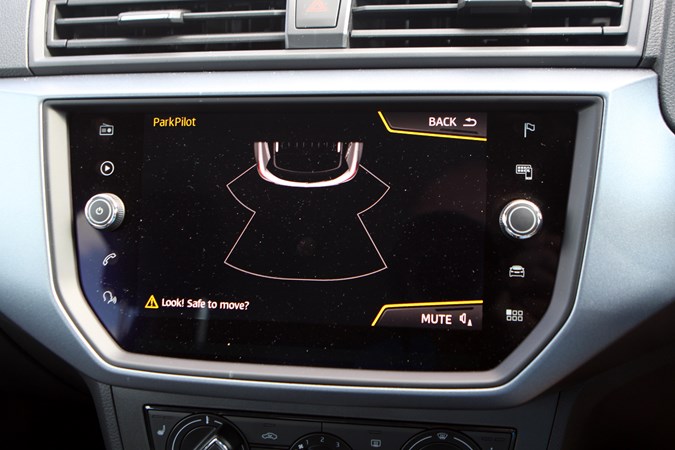
The Arona’s parking sensors warn you of obstacles behind the car. An intermittent warning tone is activated by ultrasonic sensors in the bumpers when the car comes within 1.6 meters of an obstacle and as your car gets closer, the warning tone speeds up.
When you have about 20 cms of manoeuvring space remaining, a continuous warning tone sounds. The rear parking distance warning system is switched on automatically when the car is put in reverse. In practice it works very well and the sensitivity is set on the cautious side. We were actually getting a continuous tone at around 30cms which allows plenty of room for error..
This is our penultimate update, so next time we’ll be rounding up on all the good and bad bits that caught our attention with features and functionality that made a difference in the real-world..
Update 12: OK you’re sold on it and want one – time to get some ‘Aronatherapy’
So all good things come to an end and it’s time to say farewell to the lady in red. We’ve had SEAT’s 1.6 TDi SE Technology Lux (115bhp) Arona for around seven months which was a little longer than we originally planned.
So if you fancy being an owner, here’s our round up of what impressed us the most and hit the mark and likewise what didn’t quite cut the mustard.
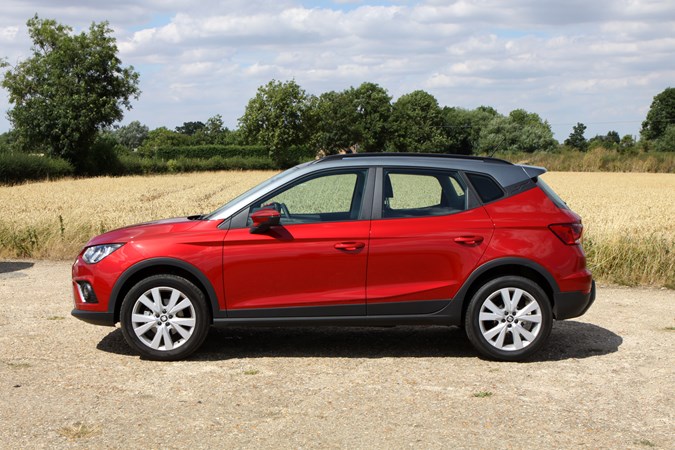
What’s hot…
- Great reliability. Throughout the loan, the car never missed a beat and has always done the job in hand
- It took four adults and a fully loaded car from Peterborough to Cornwall and back (easily)
- The heated front seats – they’re great when it’s cold and frosty
- Styling is sharp and stealthy – it looks great
- First-class dealer support and servicing options
- The navigation system works a dream – very intuitive and saved quite a few hours of unnecessary driving
- It’s a great PCP buy – See how to purchase on finance here
- It’s even a better Ca£h purchase – see your local dealer or search some great online deals like this one
- Good depreciation residuals
- Handling is quite sharp
- Excellent 5-star Euro NCAP safety rating
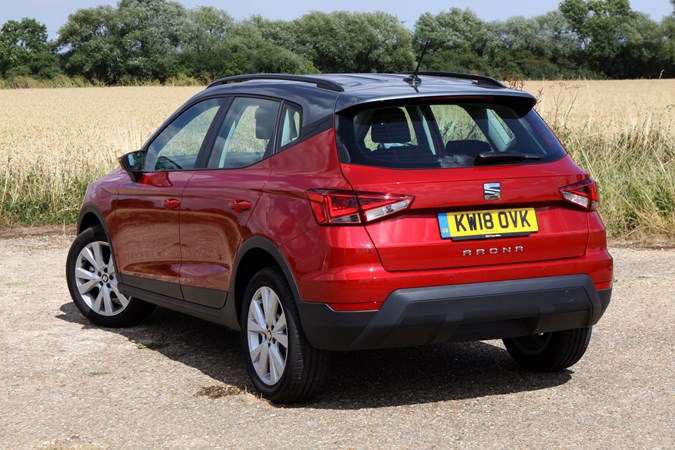
What’s not…
- Although we tried (and very hard), we could only manage an average miles per gallon of around 49 even with a multitude of experienced drivers. We couldn’t get anywhere near the claimed 68 MPG by the manufacture.
- The ‘Beats’ audio system didn’t quite hit the mark
- We think the 1.5 TSi 150bhp petrol engine would be a better choice. It costs less than the 1.6TDi (115bhp) diesel to buy and returns around the same mpg but it’s a lot more punchier
- Interior feel and quality is just ‘ok’
- Some higher end trim levels are quite expensive
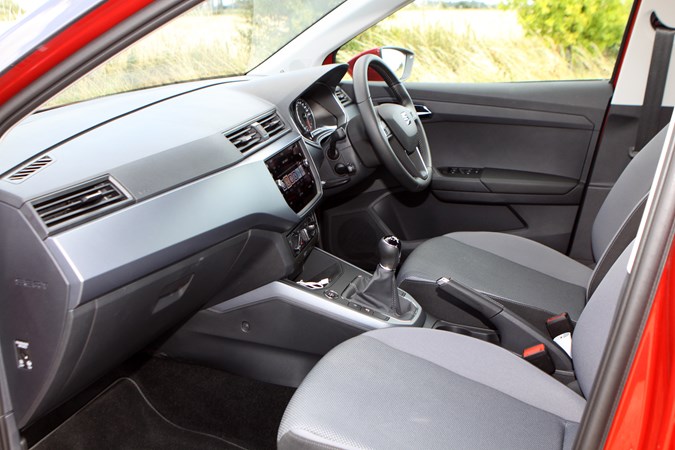
Final update: Percy Lawman – February 20th 2019
| Latest SEAT Arona running costs | |
| Current mileage | 7900 |
| Real-world average fuel economy | 49.74 mpg, (72.2% of official) |
| Official combined fuel economy | 68.9 mpg |
| Joined Parkers fleet | 11th June 2018 |



